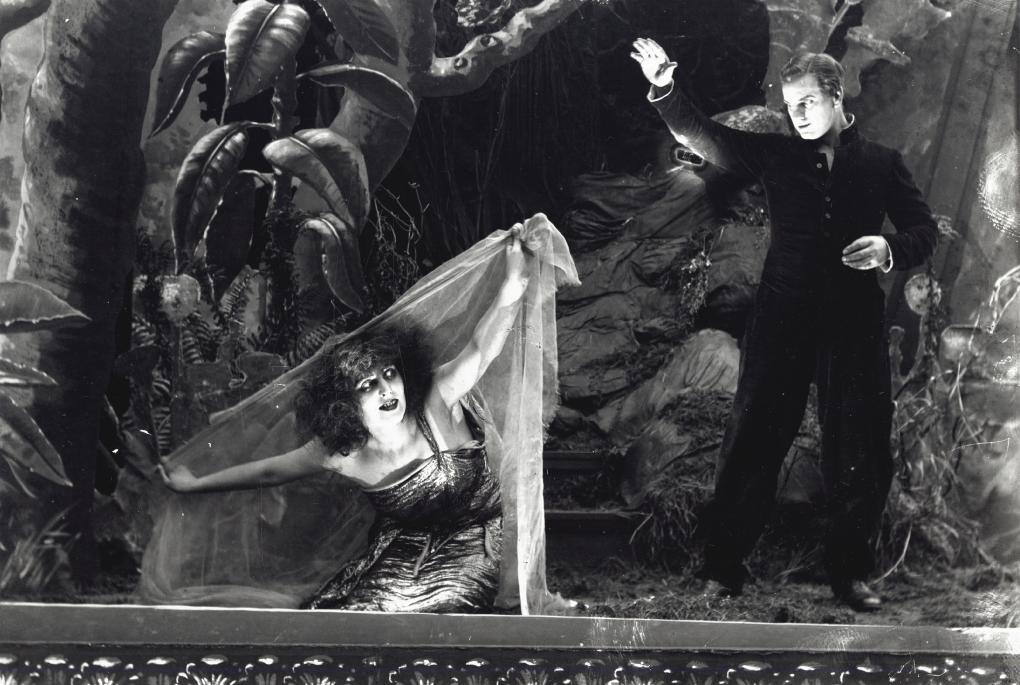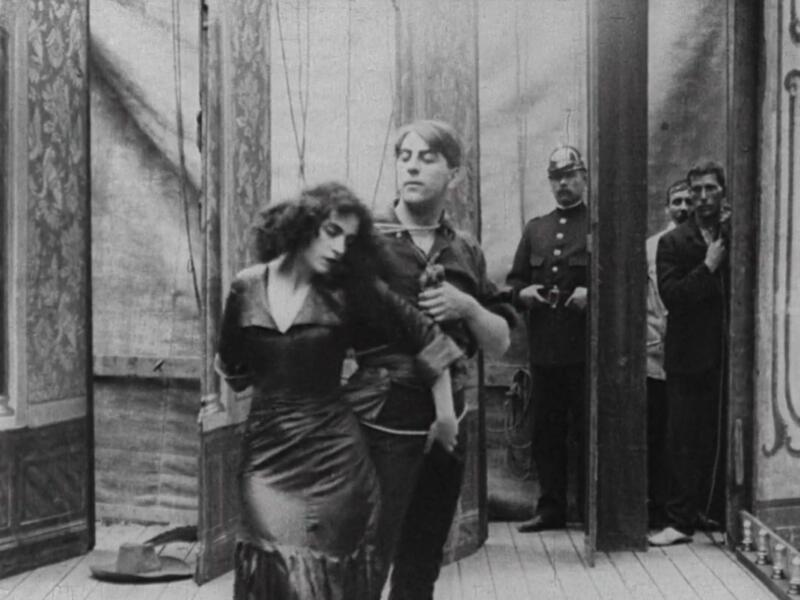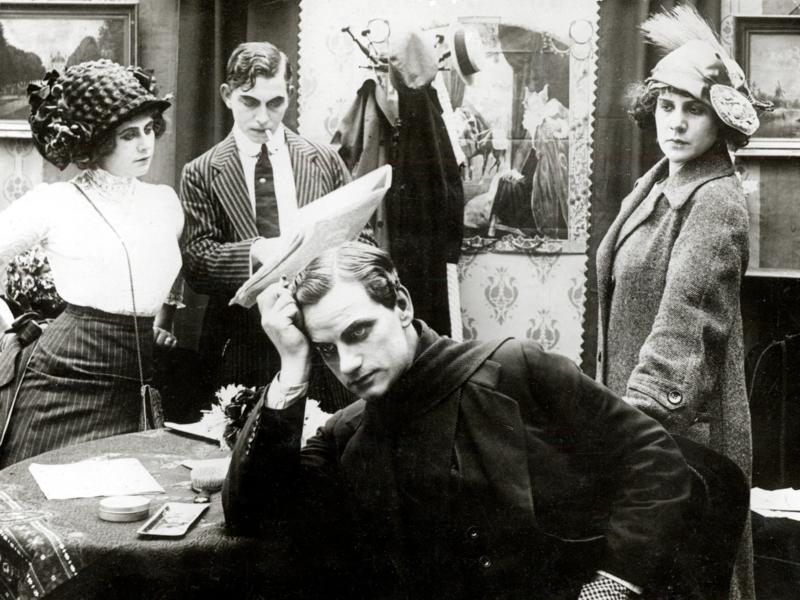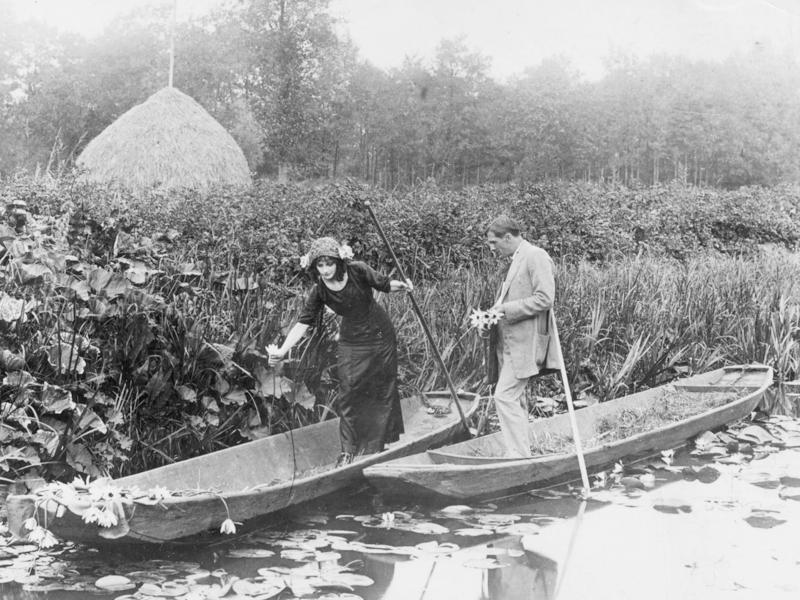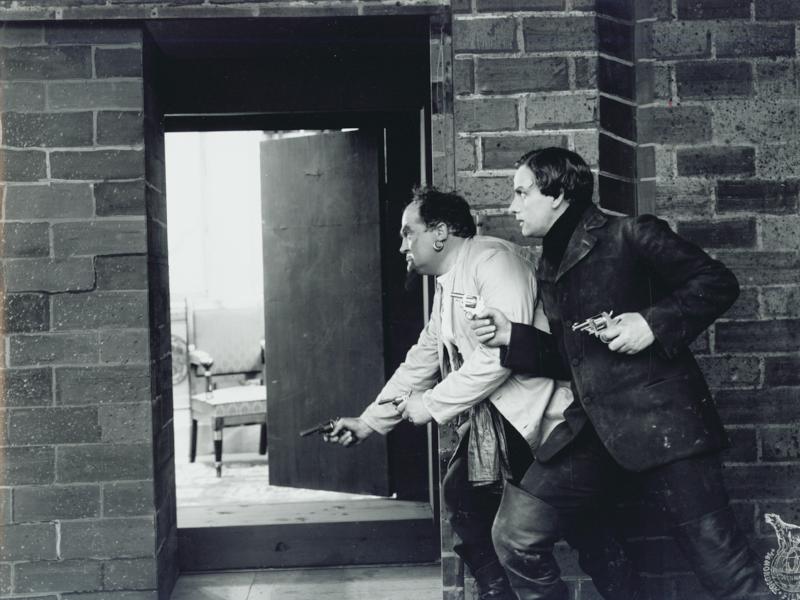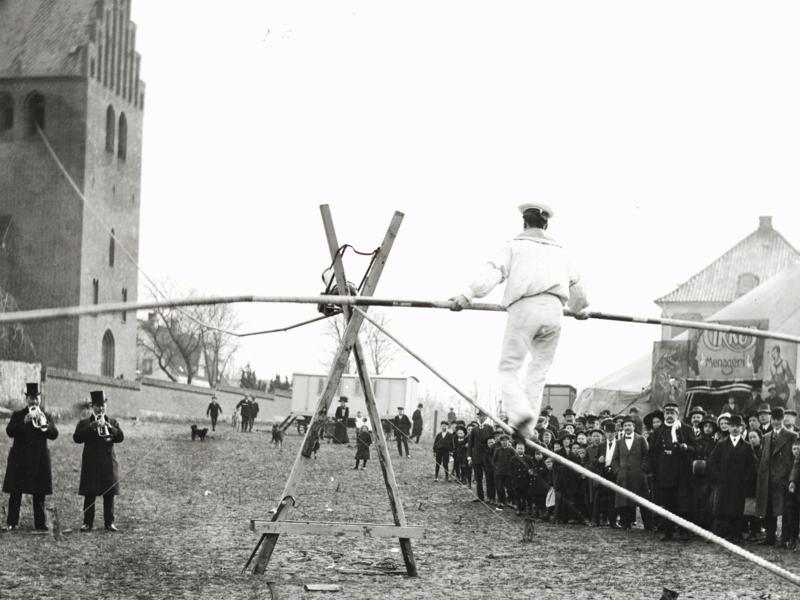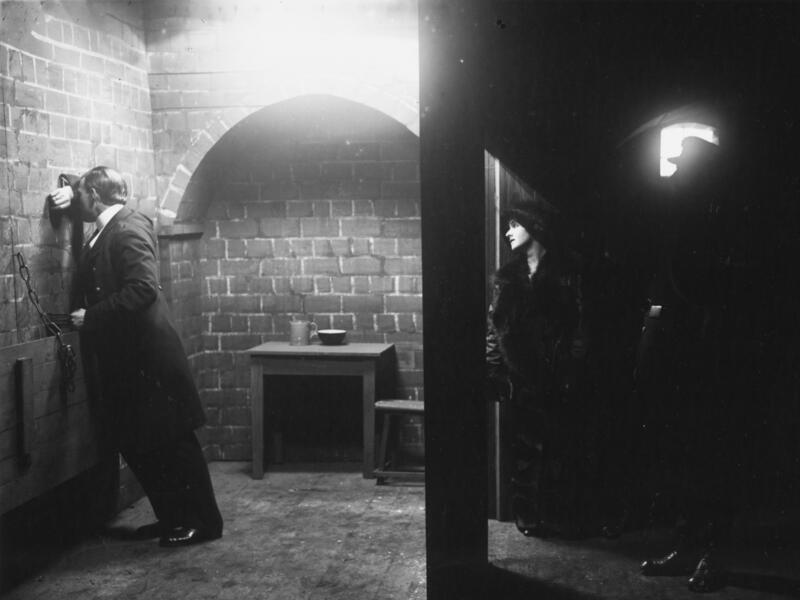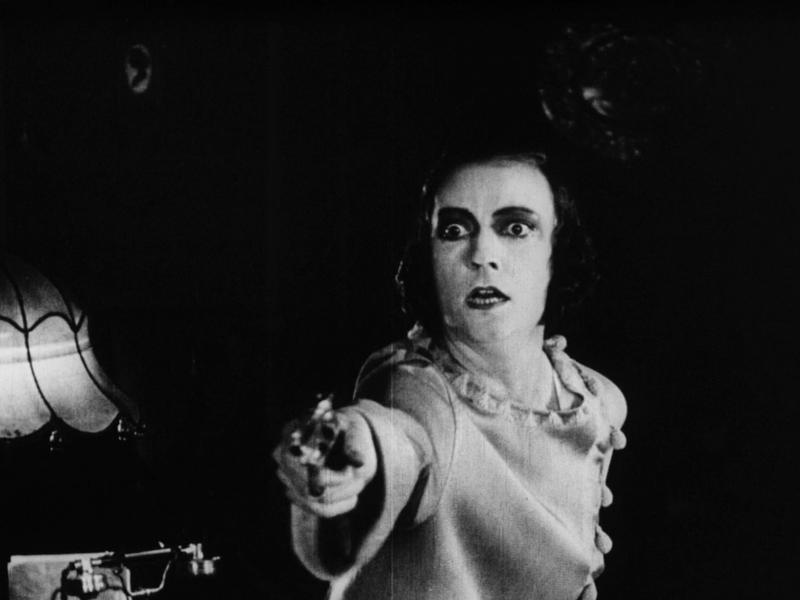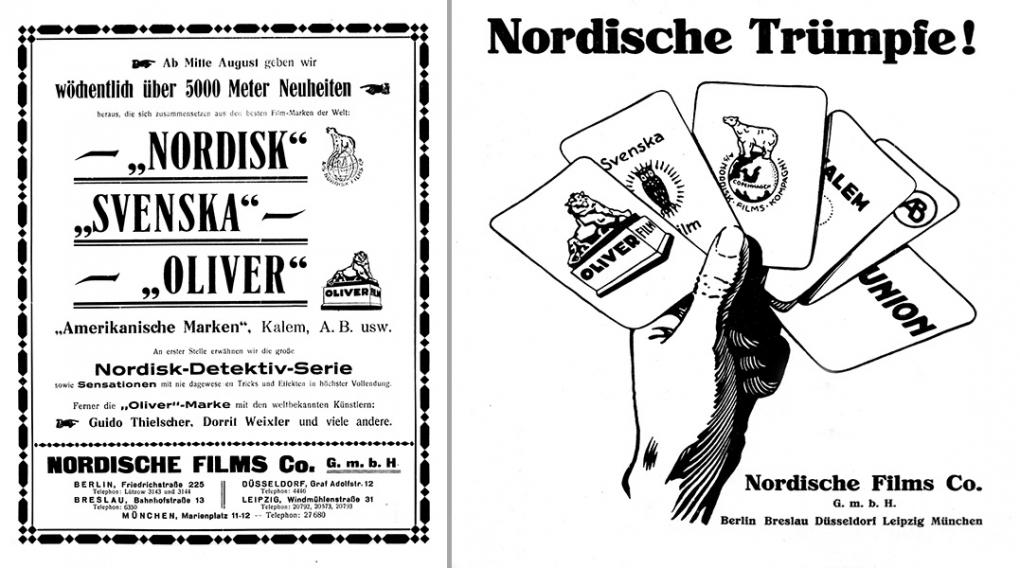
I. Introduction
How justifiable is it to assume a common Danish-German film culture before 1930? This is the central hypothesis in our research project A Common Film Culture? Denmark and Germany in the Silent Film Era, 1910–1930. One might argue that the hypothesis is either trivial or a meaningless supposition: is film culture in different countries not per se – at least to a certain degree – a common, internationalized one, taking into account the transnationality of capitalist film production and the constant flow of films, actors, directors, technicians, scripts and plots across borders? And does the very idea of being or becoming a common culture not presuppose the existence of both a Danish and a German film culture, separately from each other?
However, a common Danish-German film culture in the silent era is neither simply to be taken for granted nor a meaningless notion. To begin with, both national film markets consisted of a specific mix of both home-grown and foreign films from different countries. And although the most important Danish film companies such as Nordisk Films Kompagni, SRH/Filmfabriken Danmark, Kinografen or Dania Biofilm surely acted as global players, their products could still vary substantially on different national markets. Partly this was intentional, as was the case with the pre-produced different endings like ‘Russian’ or ‘Swedish’ ones (cf. Thorsen 2016, Thorsen 2017: 113–117, 250–252); and partly it was due to film essentially being an ‘unstable text’1 because of abridgements, newly edited intertitles, overly free translations, censorial cuts (to name just a few possibilities), and – considering film’s performative dimension – the varying film music or the explanations of the film narrator when screening the film.
Even from the audience’s point of view there was nothing like ‘transnational’ films, but rather films which for regular cinema goers were easily attributable to certain production countries. In 1914, Emilie Altenloh (1888–1985) remarked in the first German PhD-dissertation on film:
”Today, at least, one cannot even speak of any works of international cinema, and development does not seem to go this way either. On the contrary, each work clearly bears the traces of its country of origin, and in general certain national peculiarities are expressed so strongly and consistently that one can speak of just as many film types as countries that are are involved in world production.”2
Danish films, responsible for launching the successful social and moral drama in 1910, were amongst the highly recognizable ‘national’ examples in 1913, according to Altenloh (and others (e.g. Warstat 1912b)). But is this alleged national recognizability and attributability, often leading to a discursivation of their Danishness, not a counter-argument against the hypothesis of a common Danish-German film culture?
When doing research on national identities, national attributions or national differences, one of the most common traps is to resort to ‘methodological nationalism’ (Wimmer/Schiller 2002): to take ‘nation’ as a self-evident point of departure rather than to conceptualize ‘nation’ as a thoroughly performative entity which is produced by the very same discourses and practices considered in methodological nationalism to be an emanation of the ‘nation’. A category like ‘Danishness’, for example, is never stable, but permanently produced in discourses and practices, both in Denmark and abroad, and its specific semantization is constantly in motion. The films Altenloh referred to as Danish were surely of Danish origin, but it is the notion of Danishness and its semantization(s) she (and others) attribute to these films which are crucial in our context. Therefore, when dealing with the assumption of a common Danish-German film culture during the 1910s, the obvious starting point is to employ historical semantics to answer the question of what ‘Danish’ (and ‘German’, although this will not be the focus in the following) implied at that time.
Of course, this question already presupposes that the Danish films were visible on the German market and at the same time identifiable as Danish films. What kind of discourse was, then, linked to their particular ‘Danishness’ by film distributors, critics and audiences? And perhaps even more important (because easily overlooked), one has to pay attention to whether and where the category ‘Danishness’ is applied at all – or which other categories or rhetorical strategies are being used in the discourse(s) on Danish films.
As a background to the actual investigation, I will first try to estimate the share of the German film market which the Danish films accounted for before 1918. A short overview of the prevailing German discourses on Denmark around 1910 will provide a matrix to identify and assign the discourse on Danish films as the next step. After that, I will have a look at how the Danish films were marketed in Germany with regard to four strategies: northernization, Danicization, teutonization or denationalization, i.e. whether the Nordic or the Danish origin was highlighted in advertisements, if an explicit strategy of appearing to be German was pursued – or if the origin of the film was simply omitted. When studying these strategies, one has to take into account that they were also reactions to the criticism directed at Danish films in the press, especially in the articles and books written in the context of the Kinoreformbewegung (cinema reform movement), which will therefore be analyzed in the next section.
The material consulted consists of some of the most influential German film periodicals (Bild & Film, Erste Internationale Film-Zeitung, Der Kinematograph, Der Komet, Lichtbild-Bühne), publications of the so-called Kinoreformbewegung (a prominent bourgeois movement for the reform of the cinema) and other articles, a film novel, and supplementary sources digitized in The German Early Cinema Database (http://earlycinema.dch.phil-fak.uni-koeln.de).
II. Danish Films on the German Market until the End of World War I
What was the percentage of Danish-produced films on the German market up to 1918? Even if we – for the sake of convenience – assume that ‘Danish-produced’ is a clear-cut category, the question is not easy to answer, and not only due to a lack of statistical data. Even if these data were available, the share could be defined in several ways, depending on the parameters applied: as a share of distributed or sold films, as a share of total film meters shown, as a share of films censored, as a share of preferred films, and so on. However, these differentiations are of no practical relevance, as the existing data concerning the dissemination and visibility of Danish films is so sparse that only a rough statistical estimate of the presence of Danish-produced films on the German market is possible anyway.
According to German statistics quoted in the trade press, the Danish percentage of the overall German import of both exposed and unexposed film in 1912 was 4%, a minor number compared to Great Britain/USA (61%) or France (28%).3 In 1913, the percentage was 3% (”Aus der Praxis” 1914). If we take a look at the film offering in Germany, the Danish share is rather similar. Birett calculates that approximately 3% of the films available in Germany until 1911 were of Danish origin.4 This coincides with the observation that until 1911 Denmark is usually not mentioned in the German trade press whenever the most important film-producing countries are listed.5 When Altenloh in 1914 wanted to give an impression of the composition of the German film market, she used the listings of new releases published in Lichtbild-Bühne between August 15 and October 15 1912 and assessed the share of Danish films to be 3% (for comparison: France 35%, USA 29%, Italy 23%, Germany 7%, Britain 3%) (Altenloh 1914: 10). If one takes the length of the films as comparative yardstick, rather than the number of films, the share of Danish films is slightly higher, due to the averagely longer Danish film dramas (5%). Finally, figures from the Berlin censorship bureau (the most important in Germany) show that the share of film meters from the Nordic countries (‘mainly Denmark’, as is added in the listing) censored in June and September 1912 was 9% and 5% respectively (for comparison: USA 34%/31%, France 31%/28%, Italy 15%/12%, Germany 8%/17%, Britain 2%/6%) (Brunner 1914: 7).
All these figures are, of course, just snapshots with very limited reliability and comparability. Nevertheless, it is worth noting that at the same time as the Danish films were very successful and hotly debated in the German press, their market share seems to have been quite moderate – probably below 10% of the number of all films shown in Germany. However, a modification of this statement is necessary in the light of the popularity of the Danish films. Already in 1912 the Berlin censor Karl Brunner (1872–1944) emphasized that the share of films from Denmark is much higher in terms of film screenings than one would assume against the background of their share of censored film meters (Brunner 1914: 8).
Recently, Joseph Garncarz gave statistical proof of the popularity of Danish fictional films. In his sample, the Danish films – although accounting for just 3% of all films offered in the German market – reached a percentage of 6.5% in the program placement and even 10.9% in the program highlights (Garncarz 2010: 185f.). In 2015, Garncarz constructed an utilization index which takes into account the supply/demand ratio, and according to this index Denmark had the highest utilization index of all major film-producing countries in Germany during the years 1910–14 (Garncarz 2015: 69). One might object that the data basis of this utilization index (cf. Garncarz 2015: 66) is rather thin, but the particular popularity of the Danish films before the outbreak of the First World War is evident as well when browsing through the pages of the trade press with their advertisements for films offered for sale or distribution. So even when the gross share of the Danish films in the German market was rather small, the reach and cultural impact of the films were substantially higher – which is also illustrated by their importance in the cinema reform debate which raged in Germany before the First World War (to which I shall return).
The outbreak of the war had a severe impact on the German film market, as it reduced the number of competitors. The dominant French companies as well as the British had to end their engagement in Germany, later followed by their Italian and American counterparts. Companies from neutral Denmark, however, could proceed for the time being, and Nordisk in particular used the new situation to its own advantage and that of its German subsidiary Nordische Films Co. Nordische acquired control of German cinemas and took over the distribution of other brands in 1915, both German (Oliver Films, PAGU, Luna) as well as foreign (Svenska Biografteatern – which Nordisk partly owned anyway (Thorsen 2017: 163f.) – and the American companies Kalem and A.B.) (illustration 1 & 2).

When all import of films from abroad was declared illegal on February 25 1916, Nordisk Films Kompagni soon succeeded in getting an exemption, which caused quite an uproar among its German (and Danish) competitors. The company was also given a dispensation from the general import ban on films in Austria-Hungary, which came into effect on January 1 1917 (Thorsen 2017: 185). Thus, Nordisk managed to carry on with its film export to Germany until the end of the war (Thorsen 2017: 177, 179f.), while its German subsidiary Nordische became a part of the newly established UFA at the end of 1917, providing Nordisk with a substantial equity share in UFA (cf. Hampicke 1994, Behn 1995, Thorsen 2017: 157–190 on Nordisk’s engagement in Germany during World War I).
But although protected from the formerly overpowering foreign competition and enjoying a privileged status, the gross share of the Danish films in the German market did not exactly explode. In 1916, i.e. after new films from other Danish companies than Nordisk were banned from the German market, the Danish Nordisk-films accounted for 180 out of 1,316 films censored in Germany that year (15%). As a distributor, however, Nordische reigned over approximately 30% of the films censored in 1916 (Thorsen 2017: 177), but this is not to be confused with the share of Danish films in the German market. In the following year, 1917, the share of Danish films seems to have returned to the pre-war level. Among the 1,193 films (which together were 819,932 negative meters long) judged by the Berlin censors that year, just 53 films (= 4%), constituting 35,971 negative meters (= 4%), were of Danish origin (”Gesamtstatistik 1917” 1918).
All in all, Danish films were surely visible on the German market from 1906–1918, but there is no evidence that they quantitatively ever played a decisive role. Birett lists approximately 44,000 censorial decisions by the Berlin censorship bureau 1911–1918 (Birett 1980: 29), while the total number of Danish fiction films produced during this span of time was probably close to 1,138 films. Even if all of them had been released on the German market (which was not the case), these films would have accounted for no more than 3% of all censored films.
III. German Discourses on Denmark and Danishness: The Lure of Retrotopia
In Germany, the Danish films met a horizon of expectations and space of resonance shaped by stereotypes about Denmark and Danishness – which was to be expected. Surprisingly, though, the recent Danish-German history, notably the Second Schleswig War of 1864, seems not to have played any important role in the reception of the Danish films. This was because remembrance of the war in Germany and Denmark around 1910 was characterized by a fundamental asymmetry. While the war had generally had an identity-shaping function in Denmark (not at least because of the suppressed Danish-speaking population in Prussian Schleswig-Holstein), it was quickly forgotten in Germany, superseded by later wars against Austria and France. The Danish intellectual Georg Brandes (1842–1927), who himself lived in Berlin from 1877 until 1882, wrote in 1902 concerning German knowledge of the Danish population in Schleswig-Holstein:
With the exception of a few politicians and journalists, who, from the very beginning, speak ill of everything non-German within the borders of the German Empire, there are hardly twenty of the half-hundred million who suspect at all that there is a dispute between Germany and Denmark; the matter is regarded as irrevocably closed.6
And the author Herman Bang (1857–1912), after returning from his self-imposed exile in Berlin in 1909, pointed at the general goodwill Danes met in Germany, unaffected by the enmity of 1864:
The large German middle class is permeated by an instinctive benevolence towards Danes and Denmark. Many know the country from travelling, and its nature seems to be native and related to the North Germans. In the minds of the ordinary German people [...], regarding the Danes there remains the memory of a small nation with which – oh, so long ago – one had to fight, but which bravely defended itself and forced a sincere and cordial respect. This is the attitude of the ordinary people. [...]
The German population has, without any kind of ulterior motive, an unfeigned and honest respect for our country and its people. More than respect, one cherishes participation.7
True, this benevolence towards all Danes despite the Second Schleswig War was in Wilhelminian society at times mixed with condescension towards the little neighbour. But film history provides an illustrative example of how irrelevant the shared war history had become for the German discourse on Denmark and Danishness. In 1911, the Danish film En Rekrut fra 64 (A Recruit from 64, Alexander Christian, DK, 1910) was distributed in Germany and seems to have been quite a success. Although it was pointed out in advertisements that ”millions still remember this war” (which is rather doubtful after 47 years),8 the audience was obviously not provoked by a rather nationalistic Danish film about 1864, which in the preserved version ends with an intertitle wishing for a chance to avenge a slain (Danish-)Schleswigian maid.
En Rekrut fra 64 (A Recruit from 64, Alexander Christian, DK, 1910).
In my book on 1864 and its afterlife, I assumed that the film was probably screened in Germany in a much abridged version (Schröder 2019: 250), but a detailed film description in Erste Internationale Film-Zeitung seems to indicate that – although the last intertitle still might have been omitted – the rest of the film distributed in Germany was exactly as in the preserved version.9 Audiences seem not to have cared about the Danish perspective on the war (or at least the distributor did not expect audiences to care). The even more patriotic En Helt fra 64 (A Hero from 64, Gunnar Helsengreen, DK, 1910) was shown in Germany as well, advertised as a ”national war drama”,10 while on the other hand a German film about the topic (obviously the only one made in Germany in the 1910s) seems to have been a flop.11
If the war history was irrelevant for the German discourse(s) on Denmark, the Danes and Danishness, what shaped them instead? The importance of the specific German discourse on the ‘north’ can hardly be overestimated in this context. This discourse, originating with Johann Gottfried Herder (1744–1803), has already been widely described and analyzed (Arndt et al. (eds.) 2004; Bohnen 1991; Brunner 2019; Davidson 2005; Fjågesund 2014; Henningsen (ed.) 1997; Henningsen (ed.) 2002), not at least with regard to the era of Wilhelminism (Zernack 1996, Zernack 1997). Therefore it might be sufficient just to reiterate some main points and developments. Generally, the ‘north’ is constructed as a space of longing because the primordial German(ic) culture, which had been lost in Germany itself, was preserved here – the north becomes the Germans’ ”foreign homeland” (Bohnen 1991). At the beginning of the 19th century, the discourse had a cultural genealogical bent, aimed at substituting Greek and Latin mythology with Norse mythology as reservoir for poetic language and cultural expression. This discourse underwent four main interconnected alterations in the course of the century. First, the discourse became more regressive: the ‘north’ was increasingly constructed as a retrotopia (to use a term coined by Bauman 2017), characterized by sublime nature, rurality and primordality, a ”pre-capitalist idyll” (Gentikow 1978) in contrast to the rapidly modernizing Wilhelminian society with its upheavals threatening order. Second, the discourse became more imperialistic: it extended to other areas than just literature and culture and became political, for example by giving legitimation to German politics and aspirations in Northern Europe. Third (linked to the latter), the discourse became, starting in the second half of the 19th century, often interspersed with race biology, claiming a (pan)German(ic) ‘north’ which needed to be defended against the Roman, Slavic or Semitian race. Fourth, the ‘north’ assumed an eschatological-chiliastic character: to realize the ‘north’ was a task the German people had to take on, thus referring to the ‘north’ became appellative.
An illustrative example of this discourse right before the First World War is Walter Niemann’s (1876–1953) Das Nordlandbuch. Eine Einführung in die gesamte nordische Natur und Kultur (1909, The Book about the North. An Introduction to the Whole Nordic Nature and Culture). The author, a composer and music historian, sketches the image of a north which is inhabited by ”tribe-related Nordic brother people”.12 Fortunately, the people of the north still cherish ”the warm soil of the native earth, not the international culture of the cities levelling the personalities”.13 Their character traits are typical Germanic ones which are threatened in the racially related Germans of today:
Common to all nordic tribes is a whole series of genuinely Germanic virtues. Love of the fatherland and nature, stone-solid sincerity and honesty, highest hospitality. Then a purity of morals unfortunately much more admired in earlier times than today, rude bodily health and simple religiosity […].14
Taken as a whole, this discourse on the ‘north’ and ‘northernness’ had an unconditionally positive connotation, but it shaped certain expectations about cultural products coming from the actually existing Scandinavia as well – which these often could not fulfil. This was, for example, true for literature translated from the Scandinavian languages. In her seminal, heavily marxist-tinted study Skandinavien als präkapitalistische Idylle. Rezeption gesellschaftskritischer Literatur in deutschen Zeitschriften 1870–1914 (Scandinavia as pre-capitalist idyll. Reception of literature critical of society in German periodicals 1870–1914, 1978), Barbara Gentikow has demonstrated how texts from the Scandinavian authors Bjørnstjerne Bjørnson (1832–1910), Henrik Ibsen (1828–1906), Ellen Key (1849–1926) and Martin Andersen Nexø (1869–1954) were ‘disarmed’ in their criticism of society when reviewed in Wilhelminian periodicals so that they might better correspond to the ‘myth of the Nordic’, meaning ”the view of the Scandinavian countries as districts with a nature still untouched by industrialization and with a social structure that was still pre-capitalist intact”.15
IV. On the Marketing of Danish Films: Northernization, Teutonization, Danicization, Denationalization
Are there similar adaption strategies discernible with regard to Danish films encountering the ‘myth of the Nordic’ on the German market? In order to answer this question, in what follows I will first analyze the marketing of Danish films in the German trade press until 1918. It is of course important to keep in mind that these advertisements did not address a broader public, but a limited professional public, i.e. people working in the film and cinema business. However, it is still worth noting that – as will be shown – the film and distribution companies generally did not actively encourage any discursive connection to the ‘myth of the Nordic’ including a Nordic Danishness.
Leafing through the tens of thousands of pages of the German trade press in the 1910s, one encounters surprisingly few examples of a discursive northernization of the Danish films. However, in these cases the advertisements normally just underline the participation of ‘Nordic’ actors (see illustrations 3 & 4), perhaps hoping to allude to the racist image of the ‘Nordic man’ (and woman) as an epitome of beauty, proportions and health:
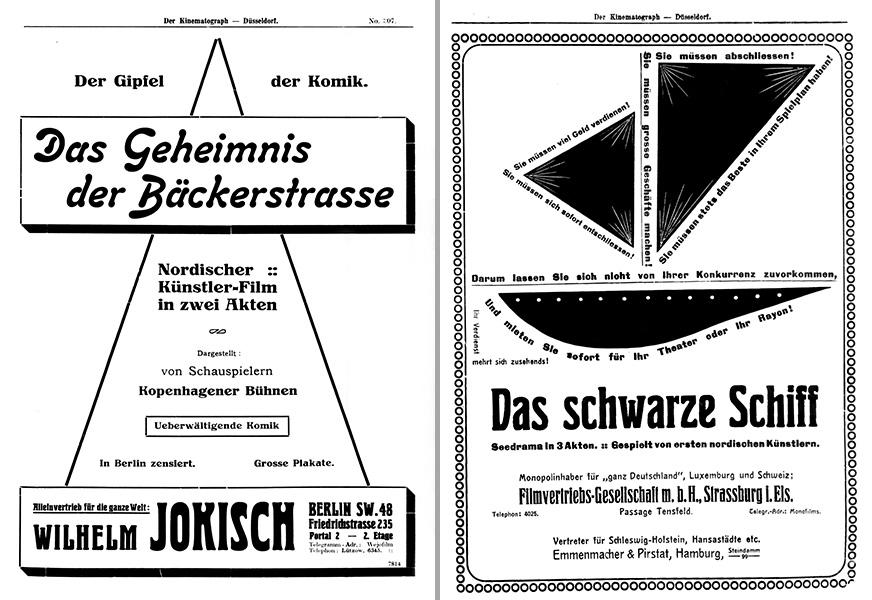
Advertising with ‘Nordic’ actors was not limited to Danish films, but could of course even be used to market Swedish films (illustration 5):

Actually, the German discourse on northernness seems to have been deployed much more to market Swedish and German films than Danish ones (with one significant temporary exception to which I will return). The Swedish Viking-Film, for example, strongly resorted to this discourse when advertising for a travelogue from Värmland by highlighting that this was ”Gösta Berling’s homeland” (illustration 6) – Selma Lagerlöf’s Gösta Berlings saga (1891, Gösta Berling’s saga), set in rural Värmland in the 1820s, had been a gigantic success in Germany and became quite influential in confirming the ‘myth of the Nordic’ (Svensson 2011).16 Another company playing the card of northernness was the German Messter which in 1914 produced a film called Die Nordlandrose (The Nordic Rose, Curt A. Stark, DE), taking place in Norway and featuring the company’s star Henny Porten (1890–1960) as ”Helga, the blond beauty of a quiet little Norwegian town”.17 This film was obviously tailored to meet a Wilhelminian audience’s expectations of ‘northernness’.
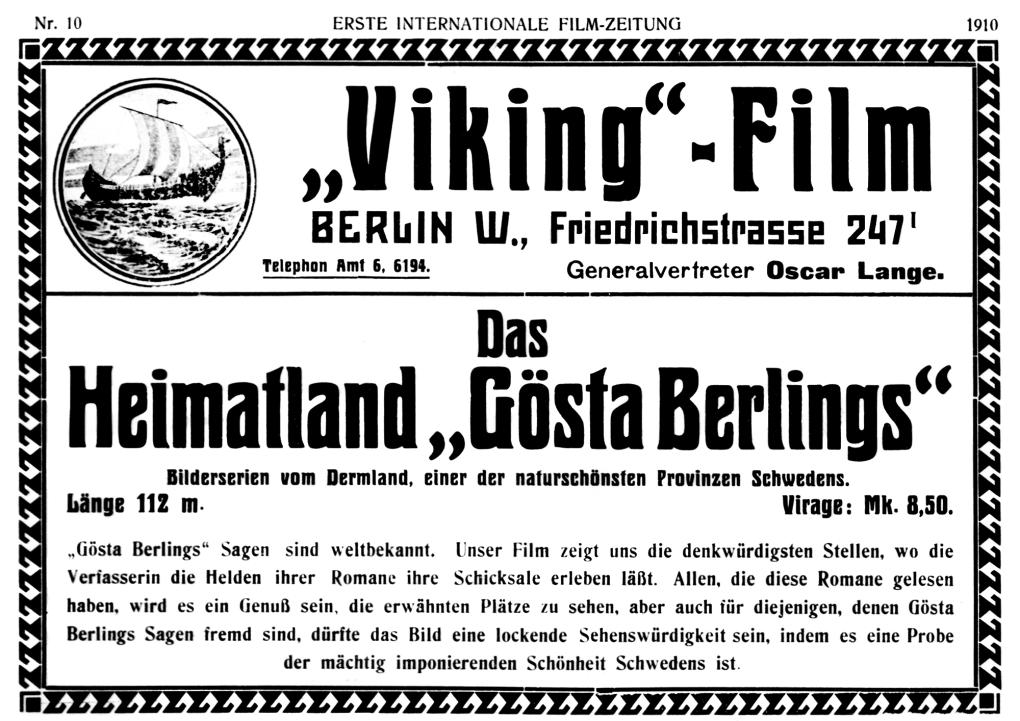
But what about Nordisk Films Kompagni, the most important Danish player in the German market? Did this company also use the positive connotations ‘Nordic’ implied? When the company opened its first branch office in Berlin in 1906, the German name came to be ‘Nordische Films Co.’, and this name was soon made prominent, not at least by advertising in the trade press Der Komet. To German ears, ‘Nordische’ certainly evoked the positive discourse on northernness. While this might have been a welcome side effect, there is no indication that the choice of the name ‘Nordisk’/ ‘Nordische’ was made with regard to its connotations in the most important foreign market. When Ole Olsen (1863–1943) started to produce films, the company was originally called Ole Olsens Filmindustri or Ole Olsens Filmfabrik (Engberg 1977: 58f.), following an already established pattern in the international film industry of using the founder’s name (as in Lumière et fils, Edison Manufacturing Co., Messter, Pathé Frères or The Hepworth Manufacturing Co., to name just a few). In September 1906, Olsen renamed his company Nordisk Films Kompagni.18 This name was quite a novelty in the film business, because at that time film companies, when not bearing their founder’s name, were using Greek-Latin loanwords with technical connotations (as in American Mutoscope and Biograph Company, Vitagraph Company of America, Società italiana Cines or Eclipse). Why the renaming took place is unclear – Olsen did not discuss the question in his memoirs (Filmens Eventyr og mit eget, 1940, The Fairy Tale of the Film and my own), and the company letters from 1906 preserved in the archives of the Danish Film Institute provide no clarification either. But it is unlikely that Olsen already at this early stage was aiming at the German market with this name change. The renaming should rather be seen as a continuation of a Danish, Scandinavism-inspired tradition resorting to the adjective ‘Nordic’ when naming companies (as for example in Nordiske Kabel- og Traadfabriker (1891), Nordisk Livsforsikrings-Aktieselskab (1897), Nordisk Bank- og Vare-Kommissions-Forretning (1899) or Nordisk Fjerindustri (1901)).
Even if the choice of the name ‘Nordisch’ was not made deliberately with regard to the German market and the positive discourse about ‘northernness’, one could still have expected the company to take advantage of its name in Germany. Surprisingly enough, this seems not to have been the case. Starting in 1913, advertisements even indicated the difference between Nordisk Films Kompagni in Copenhagen and the German subsidiary Nordische Films Co. (which could already be seen in illustrations 1 & 2). Theoretically, the effect of juxtaposing ‘Nordische’ and ‘Nordisk’ is paradoxical: while the Danish-Nordic origin of the films is emphasized when referring to ‘Nordisk’ films (a Danish word easily understandable for Germans and thus interpretable as an intentional Danicization or northernization), the German name Nordische Films Co. is decoupled from its ‘northern’ parent company at the same time, thereby weakening its geographical connection to the north. Although both interpretations are possible, the latter is more compatible with the observation that Nordische Films Co., in the years immediately preceding the war, tried to launch ‘Nordisch’ purely as a brand name, devoid of any other ‘Nordic’ denotation. Films coming from other Danish companies, i.e. from the geographical north (cf. illustration 3), Nordische Films Co. claimed, did not have the right to be called ”Nordischer Kunstfilm” (”Nordic Art Film”):

After taking over the distribution of other companies during the war, ‘Nordisch’ in the company’s name finally lost any referentiality to the north and northernness, when even German films were presented as ”Nordic easter eggs” (illustration 8, compare also illustration 2).
Although this tendency towards a geographical emptying of the term ‘Nordische’ (which at the same time deflates its potential discursive northernness) increases during the war, it is worth noting that this tendency was already discernible years before the fatal shots in Sarajevo. But after the outbreak of the war, it became one of three advertising strategies Nordische used to allay fears about its doings in a nationalistic Germany at war. Although its parent company Nordisk was very keen on underlining its neutral position in the hope of maintaining as many national markets as possible in the ongoing war, Nordische did not hesitate to take sides (illustration 9) – undoubtedly with the blessing of the parent company.
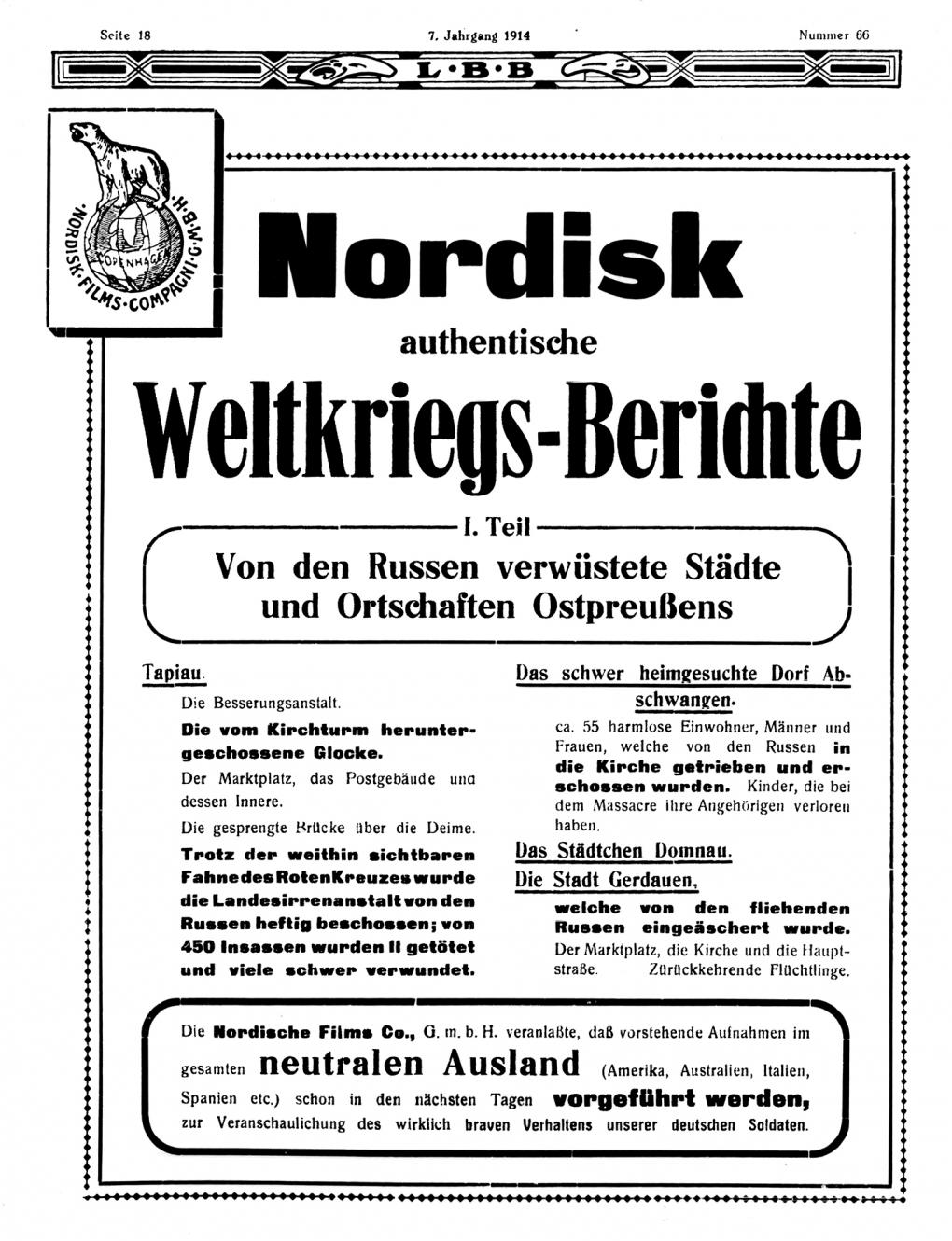
But it soon became clear that this was not enough to dispel doubts about Nordische’s loyalty to the German cause and its independence from foreign, perhaps even enemy capital, when Nordische started its aforementioned expansion policy in 1915. Especially in Lichtbild-Bühne, Nordische encountered what today would be called a veritable ‘shit storm’, even involving disputes in court. Bashing the company became commonplace in Lichtbild-Bühne in these years. Of course it is difficult to say in retrospect whether the omnipresent nationalist discourse was just a welcome tool to harm a disagreeable competitor, but the nationalist card was played strongly when criticizing Nordische as a representative of ”foreign trust capital”,19 controlled by Ole Olsen, ”the great dictator up there at the Sound”.20 When the conflict culminated at the end of 1915, the ”foreign Nordic” was accused of ”feeding us with a foreign spirit for good German money”.21 It was claimed that fighting Nordische was equivalent to the soldier’s combat in the trenches and thus a civic and patriotic obligation: ”Our German brothers out there fight and bleed for the preservation of the German existence; meanwhile the people left behind watch as a mighty polar bear (= the symbol of Nordische and Nordisk) from a foreign country spreads itself out across our native fields and snatches one booty after another.”22
In this heated mood during the war, Nordische was well advised to keep a low profile concerning its Danish origin and parent company. The first strategy was the above-mentioned geographical emptying of the term ‘Nordische’. In order to appear as German as possible, Nordische even – at least for a while, starting in late October 1914 – removed all references to Denmark and Copenhagen from its trademark (see illustration 10), as had been proposed by the Danish parent company in the autumn of 1914: 3

This marketing strategy of geographical emptying was flanked by a second, supplementary strategy, starting in late November 1914, which linked Nordische with a viking ship coming from the north, framed by two polar bears (illustration 11). At first glance, this is quite astonishing, as it seems to be very inconsistent with the strategy of geographical emptying and Nordische’s former abstinence from evoking connotations of northernness. Obviously, Nordische was at the beginning of the war pursuing a double strategy of both rendering its Danish origin invisible and at the same time playing with the most stereotypical German image of northernness – which, in a way, helped to obscure the actual Danish company in the present as well. However, this marketing strategy was abandoned in November 1915. One might safely guess that Nordische decided that advertising with a viking ship invited unfavourable associations in the heated debate about the company’s expansion policy in the German market (see illustration11).
Instead, Nordische supplemented its strategy of geographical emptying with a strategy of implicit teutonization, culminating in 1916. Of course, famous German actors like Ferdinand Bonn (1861–1933) or Rita Sacchetto (1880–1959), appearing in Nordisk’s films, or German authors like Arthur Schnitzler (1862–1931), Clara Viebig (1860–1952) or Gerhart Hauptmann (1862–1946), who at least allegedly wrote for Nordisk, had always featured prominently in Nordische Co.’s advertising. But in response to the questioning of Nordische’s devotion to the German cause, the company now emphasized its ‘Germanness’ even typographically by using Fraktur script and the Kurrent handwriting. Although there are a few examples of Nordische using Fraktur and Kurrent even before the war (e.g. illustration 12), there is a noticeable cluster of these advertisements in the years 1915 and especially 1916 (e.g. illustrations 13 & 14). The issue of using Fraktur and Kurrent was a highly ideologized one, not at least during the First Word War, as Antiqua was condemned as the ”script of the war opponents and thus as anti-patriotic and non-German”.24 Quite a few German companies showed their patriotism by using Fraktur and Kurrent during the war (especially in the first half), before returning to the more easily readable Antiqua. Foreign companies like Svenska Biografteatern did not want to take second place to this demonstration of German patriotism and used the ‘truly German’ Fraktur and Kurrent in these years as well – as did Nordische, thereby making a clear statement that it wanted to be considered as an archetypical German company (see even some of the ”Easter eggs” above in illustration 8).


Even a strategy of Danicization when marketing Danish films in Germany is not as discernible as one might expect. Only Kinografen films were, shortly before the war, explicitly advertised throughout as ‘Danish Art Films’ (illustrations 15 & 16):

Otherwise, German distributors often refrained from conspicuously playing the Danish card when advertising films, for example from Dania Biofilm or Filmfabriken Danmark. See for example how Stuart Keen (Den sorte Varieté, Vilhelm Glückstadt, DK, 1913) is introduced to the German market (illustration 17; in later advertisements for this film, even this inconspicuous hint at the Danish company name including Copenhagen was omitted).25 And when new films with the popular Emilie Sannom (1886–1931) were announced in 1916, one had to take quite a close look at her bosom in order to make out that these films were made by A/S Filmfabriken Danmark in Copenhagen (illustration 18).


However, certain advertisements liked to underline that the actors involved in the film came from the Danish stage, especially around 1911–13. This reference was of course not due to the fact that the addressees of the advertisement were assumed to be familiar with Danish theatres and their overall artistic standard. Svend Gade (1877–1952), a Danish theatre painter and director who worked in German theatre before the war (and later became both a screen writer and film director, directing e.g. Asta Nielsen’s (1881–1972) famous Hamlet (1921, Svend Gade, DE)), wrote in his memoirs Mit Livs Drejescene (The Revolving Stage of My Life) that the German audience at this time did not know anything about the Danish stage and for example ”almost imagined a Danish ballet as a collection of peasant, clumsy wooden shoe dancers”.26 Therefore, the reference to Danish theatre actors, besides emphasizing the quality of the film, relied on the symbolic capital lent to the film by the participation of actors; since 1910, Danish screen acting, by and large naturalist, had enjoyed a good reputation. Furthermore, many critics appraised the acting of Danish artists as particularly adequate for the silent screen as such.
In some cases, the reference to the participation of Danish actors in the film simply functions as a metonomy, thus weakening the attribution of the film to Denmark. The film itself is not advertised as Danish, but its Danish origin is in a way hinted at by emphasizing the Danish actors in the film (cf. also illustration 3). In illustration 19, for example, the film ”Um ein Menschenleben” (‘For A Human Life’), ”played by top members of theatres in Copenhagen”, is most likely a Danish film, although unfortunately I have not been able to identify it with certainty.27 A similar case is seen in illustration 20, advertising Dagmar die Brauerstochter (1912, Dagmar, the Brewer’s Daughter), ”played by top Danish artists”, but this time the film is identifiable as Bryggerens Datter (Rasmus Ottesen, DK, 1912; cf. Nielsen 2003: 290–304).
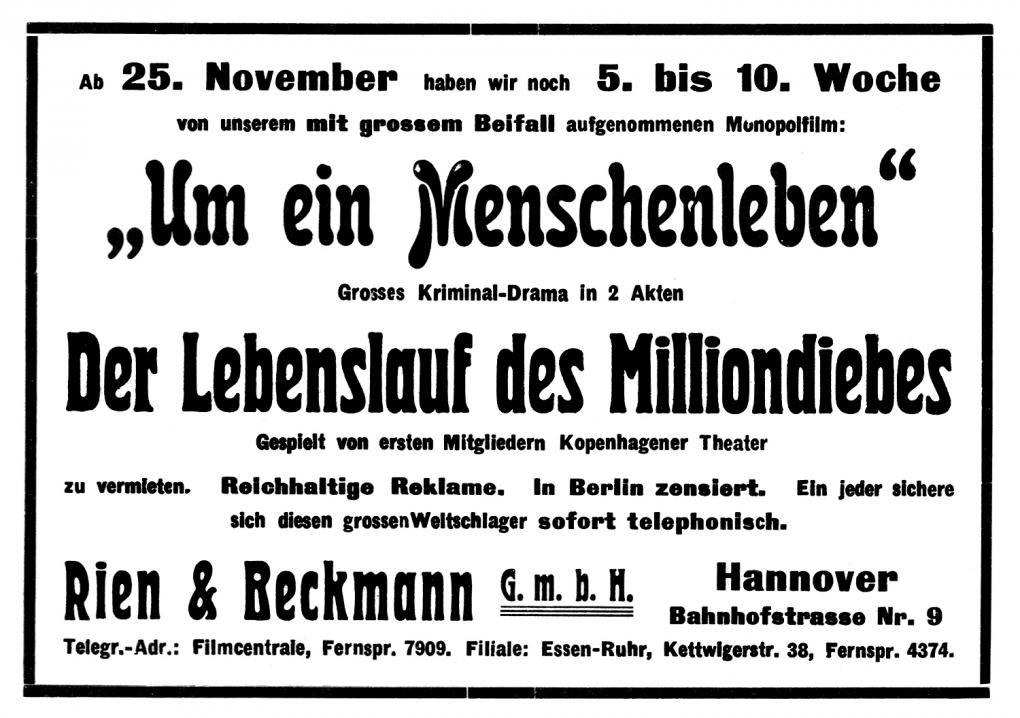
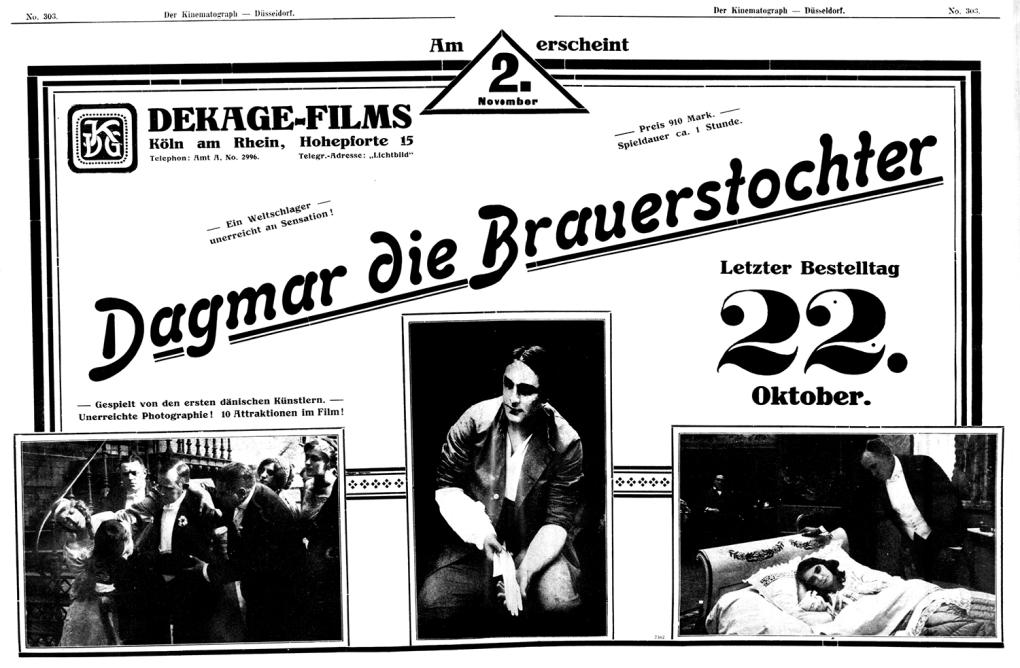
In other cases, German films (and Swedish films made by Frans Lundberg in Malmö with Danish actors (cf. Olsson 1988)) simply tried to benefit from the good reputation of Danish screen acting by directing attention towards the participating Danish stars, e.g. Lilli Beck (1885–1939), working for Lohse (illustration 21), or Maria Berthelsen (1887–1966), working for Continental Kunstfilm-Gesellschaft (illustration 22).


Finally, it is worth noting that many Danish films from other companies than Nordisk were neither discursively northernized, teutonized or danicized, as their country of origin was not mentioned at all. Whether this was an intentional strategy of denationalization or not, is, of course, impossible to say. But it certainly indicates that the distributors seem to have seen no advantage in advertising the films as ‘Danish’. Even films which nowadays are regarded by film historians as highlights of Danish filmmaking of the 1910s were not promoted as Danish. The extremely successful film De fire Djævle (The Four Devils, Alfred Lind, DK, 1911), for example, considered by contemporary critics as an artistic breakthrough which, as Balder Olden (1882–1949) wrote in Kölnische Zeitung 1912, ”should show the industry the way”,28 was originally announced without hinting at its Danish origin (illustration 23). The same is true for Benjamin Christensen’s (1879–1959) ground-breaking debut film Det hemmelighedsfulde X (Sealed Orders, DK, 1914) (illustration 24).
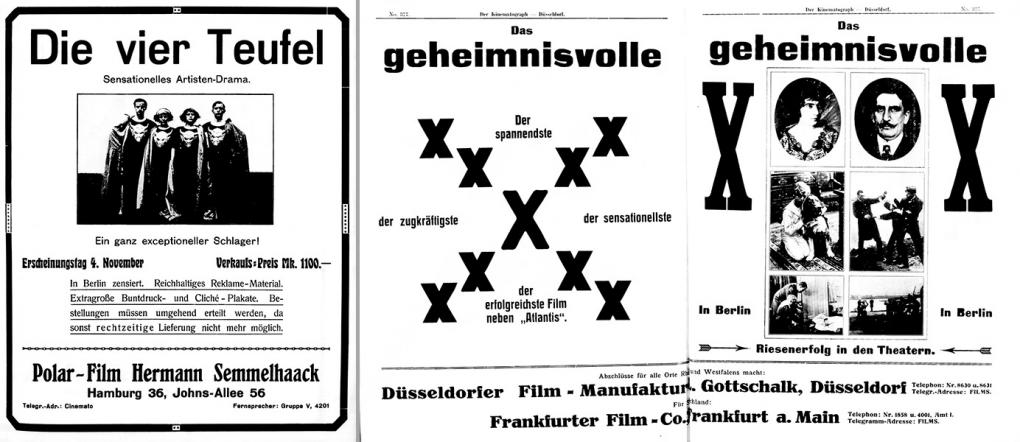
Summarizing how Danish (fiction) films were advertised up to 1918, it is striking how scarcely strategies of northernization or Danicization were employed. This is particularly noticeable in the case of Nordisk Films Kompagni/Nordische Films Co., which preferred to pursue a strategy of teutonization than to put emphasis on its specific northernness (at least in a geographical perspective).
V. The Critical Reception of Danish Films: Detachment, Omission, De-Danicization
But why did Nordische Films Co. (and to a certain extent also other Danish companies) not play upon the positive connotations of northernness when marketing their films in Germany? The answer is: the Danish films had – in contrast to Swedish and German films – nothing to gain from being situated on the horizon of the ‘myth of the Nordic’, as they could not fulfil any expectations which were connected with ‘northernness’ anyway. There was also the danger that the German discourse on northernness, when applied to the Danish films, might contribute to highlighting traits which were controversial to begin with, especially among the bourgeois critics of cinema and – even worse – among censors.
When shifting the focus from the advertisements for Danish (plus German and Swedish) films to the question of how these Danish-produced films were discursively situated in Germany, one first has to stress that before 1911 there seems not to have been a specific discourse on Danish films as such. The reasons are presumably numerous. First, audiences did not seem to have cared about the national origin of a film in the era of the Cinema of Attractions and before the breakthrough of the narrative multi-reeler (Garncarz 2015: 31–37). Second, in these early days it was often not easy to make out a film’s ‘nationality’ anyway, as names and places were often germanized. Thus, André Deed’s (1879–1940) characters ‘Boireau’ and ‘Cretinetti’ became plain-German ‘Lehmann’ or ‘Müller’ when screened in German cinemas. Third, the omnipresent critical discourse on cinema by the Wilhelminian educational elite (teachers, clergy, professors), which came into being with the breakthrough of the fictional-narrative film around 1907, concentrated in the first few years more on film as such than on specific films and their origins. And fourth, although Danish companies (notably Nordisk Films Kompagni) had been active on the German market since 1907, the decisive breakthrough came only from the end of 1910 onwards with films as Afgrunden (The Abyss, Alfred Lind, DK, 1910), Den hvide Slavehandel (The White Slave Trade, August Blom, DK, 1910), The Four Devils (1911) or Ved Fængslets Port (Temptations of a Great City, August Blom, DK, 1911), to name just a few.
Not surprisingly, taking the German discourse on northernness into consideration, the general expectations with which the Danish films were confronted concerned a tight, mentally and/or racially constituted relationship between Danish films and Germany. In a fairly hagiographic presentation of the Danish director Alfred Lind (1879–1959), the success of films like The Abyss ”in the neighbouring and consanguineous Germany” was partly explained by the German audience’s longstanding high esteem for ”Nordic and especially Danish intellectual life [”Geistesleben”]”.29 And in Der Kinematograph it was claimed that ”[t]he Scandinavian tribe is related to us in essence; therefore the film creations born out of their feelings will always be able to count on a good understanding here”.30
This, however, was not always the case. In particular, the Danish social and moral dramas, which were more or less conflated with Danish film as such in the years immediately preceding the First World War, were regarded as highly controversial by the bourgeois movement for the reformation of the cinema, the so-called Kinoreformbewegung. Unfortunately, the corpus of texts published in the context of this movement have attracted much less scholarly attention than the contemporary texts dealing with the relationship of literature to the upcoming competitor for people’s attention or texts exploring the new media’s aesthetics. Although not altogether ignored in research (cf. especially Heller 1985: 99–108, Schlüpmann 1990: 189–243; Schweinitz 1992: 55–61; Diederichs 2001, 143–208), the Kinoreformbewegung still deserves a study in its own right.
To name the most important features of the movement: its protagonists were mostly conservative academics, belonging to the Wilhelminian Bildungsbürgertum whose symbolic capital had come under strong pressure due to the industrial and perceptual modernization and economization of society, of which cinema was seen as a characteristic pars pro toto. Therefore one might argue that the real adversary of the Kinoreformbewegung was not the actual cinema, but contemporary society and its materialistic, amoral values (e.g. Häfker 1915: 27), denounced as (foreign) ‘civilization’ in contrast to (German) ‘culture’. An analysis of society as provided by the Berlin censor Brunner in 1914 is quite typical: ”Ruthlessly, blatant egoism celebrates its triumphs over all idealistic worldviews, over taste and decency, over morality, legal order and public welfare.”31
The movement originally started as a teachers’ initiative around 1907, focussing on the fatal mental, moral, cognitive and health consequences of pupils visiting the cinemas, then expanded its attention to the morally disastrous effects of cinema on the German people as a whole, before gradually toning down its pedagogical approach, turning to a more specific criticism of certain developments and films, and finally fading out towards the end of the First World War. One should, however, bear in mind that the Kinoreformbewegung as a ‘movement’ never underwent any formal institutionalization, even if numerous associations were formed which, among other things, were committed to the reform of cinema (see the listing in Samuleit/Borm 1912: 38). Rather than assuming a homogenous Kinoreformbewegung, it should be considered a cluster of writings, which were held together by a common conviction (though allowing for a certain diversity of opinion) and very pronounced intertextual references. Although some of the most important contributions were published in specifically founded periodicals (e.g. Bild & Film) and by relevant publishing houses (e.g. Volksverein-Verlag), the discussions were by no means limited to these forums, but were carried out in the daily press to a significant extent.
The Kinoreformbewegung’s criticism was not directed towards cinematography as such, but towards the fictional-narrative film (‘Kinodrama’). The cinematograph was unanimously praised as ”one of the most wonderful creations of the human mind”,32 but its scope of application should be limited to non-fictional films and its realm should be education, not entertainment and pleasure. The success of the Kinodrama, dominating the programs after 1907, was condemned as ”people’s poisoning” [”Volksvergiftung”] (Ude 1918: 13), as ”the cinema drama […] turns the cinematographic theatre into a place of devastation and destruction of all true education and spiritual elevation instead of a source of good popular entertainment and education”.33 Drawing a parallel with the fight against ‘Schundliteratur’ (‘gutter literature’), which had reached its climax shortly before, the Kinodrama was seen as the ”brother of gutter literature”34 and accordingly called ”Schundfilm” (a term coined by Hellwig 1911 (Hellwig 1911, Hellwig 1913)) or ”Schundkinematographie” (e.g. Häfker 1915: 27). However, it was supposed to be much more powerful than its literary brother, because ”the effect of the cinema image [is] by its evocativeness a far more dangerous one”,35 and it affects ”an incomparably larger number in a dulling, flattening or immoralizing direction”,36 not to mention its potential revolutionary influence (e.g. Gaupp/Lange 1912: 25; Stricker 1913: 16; Brunner 1914: 16f.).
Drawing heavily on contemporary conceptions of gender, the manipulability of the masses and mental hygiene,37 the discourse of the Kinoreformbewegung was a decidedly paternalistic one. Children, but also women, and in fact ”most adults”38 should be protected from harmful influences by sometimes immoral and corrupting, sometimes just plain irrelevant or aesthetically bad films, which were brought onto the market by unscrupulous companies indebted to speculative capitalism.
Many ready-mades of this discourse are even familiar from other countries – including Denmark (Schröder 2011: 635–783) – where similar movements had arisen following the breakthrough of the fictional-narrative film in the second half of the 1900s. What made the Kinoreformbewegung special in comparison – and relevant with regard to our discussion of German discourse on the Danishness of Danish films – is the chauvinistic attention paid to foreign dominance in the cinemas. The reasons are obvious. On the one hand, the German film market was dominated by foreign companies (especially French ones, see above), and on the other hand, Wilhelminian society was decidedly nationalistic. Although some authors tried to interpret the weakness of the German film industry as a sign of cultural health (e.g. Rath 1913: 416), the consequences in the cinemas were assumed to be fatal. The ”national-German soil” was ”undermined” by the onslaught of foreign films, wrote Eberhard Stricker (biographical data unknown), priest in Metz, in Wert und Unwert des Kinematographen (1913, Value and Worthlessness of the Cinematograph),39 and the aforementioned Brunner added that this soil ”up to now has still given us an inner moral strength and thus an advantage over many other peoples who are visibly suffering from inner decomposition. It is precisely these peoples who are now our role models and teachers”.40 Willy Rath (1872–1940), who was to become one of Germany’s most prominent screen writers in the Weimar republic, used even stronger words: the films from abroad ”often smuggle in foreign bad habits, foreign decay or even un-German physiognomies and manners as normal human or even German things” and thus contribute to the ”going to seed of the German consciousness in the masses”.41
But what were the consequences of this chauvinistic-jingoistic, sometimes even völkisch, impetus of the Kinoreformbewegung for the discourse on Danish films after 1911? Around this time, the discussions slowly started to move away from the Kinodrama as a condemnable entity in its own right and towards a critical evaluation of specific films and genres. This question is all the more pressing due to the fact that Danish films figured prominently among the films mentioned by name between 1911 and 1914 as deterrent examples. This almost canonical corpus of allegedly immoral films encompassed:
- The Abyss (translated into German as Abgründe, i.e. Abysses) (e.g. Gross 1911: 288),
- The White Slave Trade and its successor, Den hvide Slavehandels sidste Offer (In the Hand of Impostors, August Blom, DK, 1911) (e.g. Gaupp 1911/12/1992: 67; Gaupp/Lange 1912: 10, 22; Gross 1911; Noack 1913: 10; Schultze 1911: 45, 68–70, Wolff 1912: 6),
- Temptations of a Great City (e.g. Diele 1913: 11, 16),
- Den farlige Alder (The Price of Beauty, August Blom, DK, 1911) (e.g. Diele 1913: 16; Wolff 1912: 7),
- Balletdanserinden (The Ballet Dancer, in Germany translated more spicily as Brennende Triebe = ‘Burning Desires’, August Blom, DK, 1911) (e.g. Wolff 1912: 7),
- Vampyrdanserinden (The Vampire Dancer, August Blom, DK, 1912) (e.g. Gaupp 1911/12/1992: 67; Gaupp/Lange 1912: 10; von Lepel 1912: 180; Samuleit/Borm 1912: 23; Wolff 1912: 7),
- Den sorte Kansler (The Black Chancellor, August Blom, DK, 1912) (e.g. Brunner 1913: 22; Samuleit/Borm 1912: 23), and
- Den flyvende Cirkus (The Pride of the Cirkus, Alfred Lind, DK, 1912) (e.g. Gaupp/Lange 1912: 27f.).
Additionally, some of Asta Nielsen’s and Urban Gad’s early German films were also included, in particular Heißes Blut (Hot Blood, Urban Gad, DE, 1911) (e.g. Diele 1913: 16). Such Danish films were supposed to be dangerous not least because of their professionalism:
Danish companies know how to make the social drama and the moral drama, or rather the immoral drama with such refinement, psychologically credible, unassailable for censorship and nevertheless attractive to the low instinct; this branch of cinematographic trash drama today constitutes the greatest danger for the formation of taste and the ethical principles of the audience.42
How did the mostly conservative contributors in the Kinoreformbewegung succeed in tentatively reconciling the ‘myth of the Nordic’ with its emphasis on ”purity of morals” (see above) with Danish films that did not correspond to this ideal at all, but allegedly lived on ”tingling piquanterie”43 and ”sinful flirtation, dishonorable dresses, offensive dances, seduction, kidnapping, infidelity and adultery”?44 What discourse on Danishness can be seen in the contributions to the debate?
Not surprisingly, the contradiction between the ‘myth of the Nordic’ and the Danish films screened in German cinemas caused headaches for some authors. Willi Warstat (1884–?), for example, wondered ”how it came about that from these French suggestions another Germanic people, the Danes, took over and expanded the moral drama”, and answers by assuming a product differentiation strategy:
However, the Danish film industry is the youngest. In order to be able to assert itself specifically against Paris in the tough competition, it had to search for particularly gripping material and to work with particularly sophisticated means: its films had to comply with the provisions of censorship and yet offer the instincts of the large audience the strongest possible stimulants. Maybe for this reason the Danish industry took up the moral and the social drama and indeed developed it very cleverly for their purposes.45
A similar strategy — attributing the criticizable characteristics of Danish films simply to economic necessity and thus pitting them against ‘real’ Danishness — is pursued by Balder Olden (1882–1949). Olden cherished Danish films and Danish actors like Valdemar Psilander (1884–1917), Robert Dinesen (1874–1972) and Ellen Aggerholm (1882–1963), as he wrote in a long article entitled ”Dramaturgie des Lichtspiels” (1912, ”Dramaturgy of Cinema”). His esteem for Danish films is made possible by the fact that he, instead of concentrating on the films’ alleged immoral contents, focusses on the way the films are made, their exploitation of the possibilities of cinematography, the ”style of representation […] that artistically corresponds to the conditions of the apparatus”46 and not at least the art and appearance of the actors: ”I demand, following my own taste as well as for the education of the people [”aus volkserzieherischen Gründen”], beautiful, healthy people on the cinema stage, which for a thousand reasons can never become a Strindberg stage. Beautiful, healthy people and beautiful, healthy humanities.”47
It is not only this praise of Nordic beauty and health, implicitly directed against a sick, degenerate Strindbergian society, that exemplifies Olden’s recourse to the ‘myth of the Nordic’; also relevant is his simultaneous attack on Asta Nielsen as the ”great corrupter” who cultivates the ”charm of the unhealthy” 48 By directing against Asta Nielsen similar hygienic arguments as the Kinoreformbewegung used when condemning the Danish moral drama, he redirects the criticism normally heaped upon Danish films in general towards an adversary who figured, for the Kinoreformbewegung, as an embodiment of immoral and vicious morbidity. At the same time, he maintains that Asta Nielsen ”found her sphere of activity not only by chance in Germany”:49Germany, not Denmark is the soil in which a decadent actress like Asta Nielsen thrives.
How Olden tries to free the Danish film industry from the accusation of producing films that are incompatible with his – and others’ – idea of ‘Danishness’, is even more obvious in his film novel Schatten (Shadows) from 1914, one of the earliest German film novels. In this novel, the protagonist falls in love with a girl on the screen, and as the film in question was made by a Danish company, he travels to Copenhagen to find the girl (who in the end, however, turns out to be his German cousin).
Denmark is described as a stereotypical Nordic country where ”everything was so free and healthy, all people made the impression of being more carefree, lighter and cleaner in body and soul than the people of other countries”.50 Of course, the children have either ”lightning blonde” (”blitzblonde”, Olden 1914: 140) or ”cereal yellow” (”getreidegelb”, Olden 1914: 141) hair, and the danophile narrator comments that ”no nation has more beautiful human material than Denmark”.51 The Danish company responsible for the film in Olden’s novel is led by Palle Henningsen, a ”racy Dane” (”rassigen Däne”, Olden 1914: 116), ”who came along like a knight of the Middle Ages, high and stately, with flashing eyes”,52 reminding the narrator at other times of ”a prehistoric man with sensitive nerves – one could trust that he would have swung the halberd as mercenary pikeman in another time, but also that he as a sculptor would knock a psyche out of marble”.53 In the present, however, Henningsen makes films out of the humans he works with – and as a true artist he would prefer not to make sensational kitsch, if only the market would reward such efforts (Olden 1914: 122). The protagonist, on the other hand, experiences the decadent, morally charged world of acting, where appearance and naked skin are more important than voice and talent, tellingly enough in connection with a German performance troupe visiting Copenhagen.
Olden – an avowed jew, driven into exile in 1933 – was not part of the Kinoreformbewegung, as is evident from his general admiration for Danish films and his emphasis on the aesthetics and technical possibilities of cinematography rather than the immoral content of films. But his articles and his novel demonstrate, on the one hand, how common racially-influenced notions – not at least with regard to ‘northernness’ – were in Wilhelminian society, and on the other hand, how widespread was the awareness of the contradiction between the discourse on Nordic ‘Danishness’ and the Danish moral drama.
A different, frequently chosen way of dealing with this contradiction in the Kinoreformbewegung was simply not mentioning the Danish origin of the criticized films – whether consciously or unconsciously. Konrad Lange (1855–1921), for example, professor of aesthetics and art history, discusses at length in his widely quoted article ”Der Kinematograph vom ethischen und ästhetischen Standpunkt” (”The Cinematograph from the Ethical and Aesthetic Point of View”, 1912) both The White Slave Trade and The Pride of the Cirkus, but without once referring to their Danish origin. And when Lange mentions the national economic problem that ”a large part of the money that the little man carries into the cinemas in our country” goes abroad, he just lists France, the U.S.A., England and Italy (Gaupp/Lange 1912: 47). Another illustrative example can be found in Stricker’s aforementioned monograph. Although he is outraged by ”the so-called Nordic social dramas” and ”the sultry films of the cinema artist Asta Nielsen”, some pages further on, when Stricker is complaining about what one has to put up with from foreigners in cinema, only Frenchmen, Italians, and Americans are mentioned.54 This blanking out of the Danish origin is even observable when Danish films are reviewed, for example in Bild & Film, which was a mouthpiece of the Kinoreformbewegung: as might be expected, Zigo (director unknown, DK, 1914) gets no praise from the reviewer at all, but the Danish origin is not mentioned either.55
Of course such omissions might have to do with the fact that Denmark was not considered to be one of the countries ”which are vividly interested in our downfall” (as Brunner wrote),56 meaning especially France and Great Britain, the future war enemies. In a way, the Danish cinema dramas were a moral threat, yes, but Denmark was not, neither as a state nor as a culture. However, discursively erecting a wall between the specific films and Denmark as part of the north, thereby in a way de-Danicizising the films, also helped in coping with the contradiction between the German discourse on northernness and the blatant need for criticism of the Danish films.
One wonders how far this de-Danicization of Danish films for the (implicit or explicit, conscious or unconscious) sake of adhering to the ‘myth of the Nordic’ could go. One telling case is a film exploiting the topic of white slavery, discussed in Ernst Schultze’s (1874–1943) Der Kinematograph als Bildungsmittel (1911, The Cinematograph as Educational Resource). The film is referred to as Edith, die weiße Sklavin (Edith, the White Slave) and allegedly takes place in France, i.e. it is assumed to be a French film, tempting the audience to indulge in ”erotic escapades”.57 However, the detailed presentation of the content, quoted from the newspaper Berliner Tageblatt, leaves no doubt that the film in question is the Danish film The White Slave Trade from 1910 (either Nordisk’s version or Fotorama’s). Did Schultze deliberately disguise the film as French, although he knew it was Danish, because Edith, die weiße Sklavin did not fit into the ”purity of morals” associated with northernness? This seems unlikely, but the misattribution is nevertheless telling. Obviously, for Schultze the film corresponded all-too-neatly to his ideas about French films, made – as he wrote – for ”street audiences in French port cities or in Tunis or Algiers, for cinematograph visitors in semi-illiterate countries such as Spain or Portugal, for local cinema audiences in Asia or Africa”.58 A film presumably addressing such people in the south and primitives overseas could simply have nothing to do with the north.
The outbreak of the war in 1914 could have aggravated the discursive conflict between Danish film production and traditional German conceptions of Nordic ‘Danishness’, because the expectations of the morality and sanity of films were raised even further. Prominent critics like Hermann Häfker (1873–1939, murdered in a concentration camp) or Malwine Rennert (1856–? (but after 1938)) evoked the purifying power of war. It brings ”liberation from such a load of cultural mud, inside and out”,59 wrote Häfker, thus becoming ”the greatest cinema reformer of all”,60 and Rennert called for ”cinema reform to take the decisive step and destroy all the sick, rotten, and infamous in its field. German must be the direction; German, i.e. healthy and noble”.61 However, the moral criticism of Danish films seems to have diminished, which might have to do – at least with regard to Nordisk’s films – with a change in the production policy. Accordingly, the image of the Danish films was no longer dominated by moral dramas and sensational films, but rather by Autorenfilm and similar high brow ambitions which did not contradict popular German discourses on Danishness and northernness, but fit them (or could be made to fit). Thus, in Bild & Film, the Kinoreformbewegung’s own mouthpiece, the film journalist Alfred Rosental (1888–1942, murdered in a concentration camp) wrote that ”now [...] all own products of the ‘Nordische’ have a typical northern [”nordländisches”] character, and it was known for a long time that the ‘Nordische’ wanted to take pictures which correspond completely to the German taste”.62 By using the term ‘nordländisch’ instead of ‘nordisch’, Rosental underlines that he refers to the discourse on northernness63 and not to a possible branding of the term ‘nordisch’. As discussed above, however, the Nordisk/Nordische did not put its trust in promoting such a connection between northernness and its films, but rather relied on a strategy of teutonization, thereby trying to render its northern/Danish origin invisible.
VI. An Emerging New Discourse on Danishness?
The German reception of Danish films up to 1918 is, of course, not limited to the advertisements, the debates in the trade press and the critical texts by the Kinoreformbewegung which I have dealt with in this article. After all, to describe the reception by analyzing the thematization of the social and moral drama in the texts of the Kinoreformbewegung certainly involves a bias, both with regard to the genre as well as the criteria used by this movement in its criticism. Certainly, the importance of the Kinoreformbewegung was immense: ”Before the First World War, there was virtually no independent publication on the aesthetic and social tasks of cinema that did not belong in this context”, as Schlüpmann claims.64 But it should not be forgotten either that Danish films generally were extremely popular, not just with audiences, but even with a lot of critics (the above-mentioned Balder Olden is a good example) – and sometimes these were the very same moral dramas which were so heavily condemned by the Kinoreformbewegung, although, admittedly, most of these positive reviews are to be found in the trade press.65
However, an explicit notion of Danishness usually does not play a role in these more positive articles. Or, one might even argue, a new discourse on Denmark and Danishness gradually comes to the fore in in these texts (and in a way also in the more negative ones dealt with in this article). However, this new discourse is not yet conceptualized as ‘Danish’: it concerns Denmark not as part of a pristine north, but Denmark as a modern, secular, urbanized society, claiming freedom of thought and equal rights for women. As mass media, the Danish films that could not be reconciled with the ‘Nordic’ semantization of Danishness in Germany contributed quite decisively to this new popular semantization of Danishness, as did well-known Danes like Asta Nielsen or Georg Brandes at this time. Julie K. Allen has recently analyzed in Icons of Danish Modernity. Georg Brandes & Asta Nielsen (2012) how these two as ”iconic Danish celebrities of the time” (Allen 2012: 11) disseminated ”an image of Danish cultural modernity to the world” (Allen 2012: 14f.), not at least by their use of mass media. Although both were rather controversial in their home country and although the social and cultural conditions in Denmark at that time did not correspond to the image of modernity Brandes and Asta Nielsen conveyed, they nevertheless contributed to ”the development of a generalized exo-stereotype of Danish cultural modernity” (Allen 2012: 19). In Wilhelminian times, this discourse on ‘modern Denmark’ was only beginning to emerge sketchily, but in a discourse-historical perspective it points forward towards an image of Welfare-state Scandinavia as a laboratory of modernity, coming to full force after the Second World War (Musiał 2001, 2002).
Returning to this article’s introductory question about the common Danish-German film culture, one can conclude that the reception of Danish films in Germany up to 1918 with regard to the discourse on their Danishness clearly indicates that the Danish-German film culture was, indeed, mostly constructed as a common one – yet based on different premises. From the perspective of the Danish film industry and the distributors of Danish films, a common film culture primarily meant a common market. Therefore, the Danish origin of the films was downplayed in advertisements or they were at least typographically teutonized. As the films contradicted the ‘Nordic’ semantization of Danishness, there was not much to gain by emphasizing them as ‘Danish’, i.e. as coming from abroad, or as ‘Nordic’.
For the German film producers and distributors, on the other hand, this common market increasingly looked like a spectre of menace with Nordisk’s expansion policy during the war. Accordingly, Nordisk/Nordische was branded as a foreign intruder, not least in the eminent trade press Lichtbild-Bühne, with a view to excluding the company from the German market, at least discursively. However, it is worth noting that the parameters of this exclusion were solely economic and had nothing to do with the content of the films, i.e. whether these films were in accordance with or contradicted the ‘myth of the Nordic’.
This question, however, was obviously an issue in the films’ reception by the Kinoreformbewegung which was faced with films not matching the ‘myth of the Nordic’. Interestingly enough, the strategies of omission and de-Danicizing employed in the movement’s texts were rather similar to the strategies used for advertising Danish-produced films – but the reasons and goals were very different. In the texts of the Kinoreformbewegung, it is the discursive conflict stemming from the incompatibility of the films with ‘the myth of the Nordic’ which is solved in a way by not marking the films as ‘foreign’, so that the ‘myth of the Nordic’ remains intact. Seen in the light of the texts analyzed here, the common film culture is not founded on economics, but is, rather, the result of a deeply-rooted cultural relationship, even kinship, which transcends the realm of cinema.
Notes
1. The notion of an ‚unstable text’ has been taken from medieval studies, cf. Bumke 1996: 125: ”Wir müssen mit unfesten, beweglichen Texten rechnen, die sich verändern können, ohne daß die Veränderungen als Störungen zu begreifen wären. Mittelalterliche Texte sind nicht zuerst fixiert und dann nachträglich verändert worden, sondern der ‚Text‘ ist von Anfang an eine veränderliche Größe.” (”We have to reckon with unstable, moving texts which can change without the changes being understood as disturbances. Medieval texts were not first fixed and then subsequently altered, but the ‘text’ is from the outset a variable quantity.”) In an analogous way, films (as cultural texts) should not be considered to be fixed, thus implying the notion of an ‘original’ versus regrettable later deviations, but are rather characterized by a similar fluidity.
2. ”Von irgendeinem internationalen Kinostück kann man, heute wenigstens, noch gar nicht reden, und die Entwicklung scheint auch nicht dahin zu zielen. Im Gegenteil trägt jedes Stück deutlich die Spuren seines Herkunftlandes an sich, und im allgemeinen kommen bestimmte nationale Eigentümlichkeiten so stark und durchgängig zum Ausdruck, daß man von ebensoviel Filmtypen sprechen kann, als Länder an der Weltproduktion beteiligt sind.” Altenloh 1914: 11.
3. Quoted in Rath 1913: 416f. Rath refers to the official statistics, but his source is probably the trade press, e.g. the article ”Vom Markt” in: Bild & Film vol. 2, no. 6 (1912/13), p. 150.
4. Birett 1991: XVI. Birett is well aware of the methodological objections one could raise against his calculation, ”but the scale will be right” (”[a]ber die Größenordnung wird stimmen”).
5. A few examples: when Arthur Spamer lists the most important film industries in 1909, Denmark is not mentioned (”Zur Krisis in der Filmindustrie”. In: Erste Internationale Film-Zeitung vol. 3, no. 30 (22/7 1909)). In 1910, film journalist Hermann Häfker writes a long report about the offices and storage of the international film companies in Berlin which every week receive films from abroad – and once again, Denmark is omitted (”Eine Reise an die Quellen der Kinematographie”. In: Der Kinematograph no. 163 (9/2 1910)). And when ‘Niko’ scrutinizes the different artistic domains of film-producing countries in March 1911, only France and the U.S.A. are discussed (”Der Idealismus in der deutschen Kinematograpie”. In: Der Kinematograph no. 220 (15/3 1911)).
6. ”Med Undtagelse af en Del Politikere og Bladskrivere, der paa Forhaand er uvillig stemte mod alt Ikke-Tysk indenfor det tyske Riges Grænser, er der blandt de halvhundrede Millioner vel knap en Snes Mennesker, som overhovedet aner, at der gives et Mellemværende mellem Tyskland og Danmark; det, der en Gang var, betragtes som uigenkaldeligt afsluttet.” Brandes 1905: 69.
7. ”Den store tyske Middelstand er gennemtrængt af en instinktmæssig velvilje mod Danske og Danmark. Mangfoldige kender Landet fra Rejser, og dets Natur synes Nordtyskere hjemlig og beslægtet. I det brede tyske Folks Sind […] er der om de Danske blevet Erindringen om en lille Nation, med hvilken man – aa, for meget længe siden – maatte kæmpe, men som forsvarede sig tappert og aftvang en oprindelig og hjertelig Agtelse. Dette er det bredere Folks Sindelag. [...]/ Den tyske Befolkning nærer, uden nogen Art af Bagtanke, en uskrømtet og ærlig Agtelse for vort Land og dets Folk. Mer end Agtelse, man nærer Deltagelse.” Bang 1909: 383.
8. ”da sich noch Millionen dieses Krieges erinnern”. In: Erste Internationale Film-Zeitung vol. 5, no. 16 (22/4 1911); Der Kinematograph no. 225 (19/4 1911).
9. ”Düsseldorfer Film-Manufaktur: Der deutsch-dänische Krieg 1864”. In: Erste Internationale Film-Zeitung vol. 5, no. 14 (8/4 1911).
10. Erste Internationale Film-Zeitung vol. 5, no. 2 (14/1 1911). Cf. even Schröder 2019: 252.
11. The film titled Unter dem Doppeladler (1912, Under the Double-Headed Eagle) or Unter dem Adler (Under the Eagle) is just being mentioned once in advertisements when it came out, indicating that the demand for this film was rather low: Erste Internationale Film-Zeitung vol. 6, no. 41 (12/10 1912); Der Kinematograph no. 305 (30/10 1912) (here Martin Dentler advertised that he had available 15 copies of this film).
12. ”stammverwandten nordischen Brudervölker”. Niemann 1909: VII.
13. ”die warme Scholle der heimischen Erde, nicht die internationale und die Persönlichkeiten nivellierende Kultur der Städte”. Niemann 1909: 159–161.
14. ”Gemeinsam ist allen nordischen Stämmen eine ganze Reihe echt germanischer Tugenden. Vaterlands- und Naturliebe, kernfeste Ehrlichkeit und Aufrichtigkeit, höchste Gastfreundschaft. Dann eine leider in früheren Zeiten viel mehr als heute bewunderte Sittenreinheit, körperliche derbe Gesundheit und schlichte Religiosität […].” Niemann 1909: 64f.
15. ”die Auffassung der skandinavischen Länder als Distrikte mit einer von der Industrialisierung noch unberührten Natur und mit einer Gesellschaftsstruktur, die noch präkapitalistische Intaktheit aufwies”. Gentikow 1978: 238.
16. In a way, this kind of ‘Nordic’ advertisements for Swedish films is an antecedent to the marketing and reception of Swedish films in Germany in the early 1920s (cf. Vonderau 2005: 140–159), concentrating on literary adaptations, not at least of Selma Lagerlöf’s novels.
17. ”Helga, die blonde Schönheit eines stilles norwegischen Städtchens”. Review of the film in: Der Kinematograph no. 418 (30/12 1914). For more information on the film see https://de.wikipedia.org/wiki/Nordlandrose
18. Nordisk Brevkopibog IV: 335, Nordisk Collection, Danish Film Institute, Copenhagen.
19. ”ausländische Trustkapital”. ”Die Deutsche Bühnengenossenschaft gegen die ‚Nordische‘” 1916.
20. ”der große Diktator oben am Oeresund”. ”Indiskreter Brief aus Filmsdorf” 1916: 13.
21. ”Die fremdländische Nordische füttert uns für gutes deutsches Geld mit fremdem Geist.” ”Carl Gabriel – jetzt Nordische!” 1915: 13.
22. ”Unsere deutschen Brüder dort draußen kämpfen und bluten für die Erhaltung der deutschen Existenz; währenddessen schauen die Zurückgebliebenen zu, wie sich ein mächtiger Eisbär aus fremdem Lande auf unseren heimischen Fluren breit macht und ein Beutestück nach dem andern an sich reißt.” ”Weitere Ausdehnung der Nordischen” 1915.
23. See Thorsen 2017: 159 for the letter in question from Nordisk. Thorsen, however, writes that this proposal was not carried out.
24. ”als Schrift der Kriegsgegner und damit als vaterlandsfeindlich und undeutsch”. Beck 2006: 258.
25. Cf. the advertisements in Erste Internationale Film-Zeitung vol. 7, no. 9 (1/3 1913); Erste Internationale Film-Zeitung vol. 7, no. 11 (15/3 1913). In Erste Internationale Film-Zeitung vol. 7, no. 13 (29/3 1913), at least it was mentioned that the film was ‘Dänisches Fabrikat’.
26. ”nærmest forestillede sig en dansk Ballet som en Samling bondeagtige, klumpe-dumpe Træskodansere”. Gade 1941: 63.
27. Birett assumes incorrectly on the basis of this advertisement that Der Lebenslauf des Millionärs (The Life Story of the Billion Thief) is the German title of a Danish film (cf. Birett: 1991: 389), but a plot description published in Lichtbild-Bühne no. 38 (23/9 1911, p. 19) leaves no doubt that ‘The Life Story of the Billion Thief’ is just a resumé and not the title of the film which allegedly had a length of 800 m.
28. ”sollte der ganzen Industrie den Weg weisen.” Olden 1912 (I). A similar assessment of the historical significance of The Four Devils can be read in Baumann-Ammann 1912: 9.
29. ”das nordische und insbesondere das dänische Geistesleben”. ”Dänemark und Deutschland in der Filmkunst”. Published both in Erste Internationale Film-Zeitung vol. 6, no. 18 (5/4 1912), and in Der Kinematograph no. 280 (8/5 1912).
30. ”Der skandinavische Volksstamm ist uns ja wesensverwandt; deshalb werden auch die aus seinem Empfinden herausgeborenen Filmschöpfungen hier immer auf gutes Verständnis rechnen können”. ”Geschäftliches”, ”Berlin” (about the opening of a branch office by Svenska Bio). In: Der Kinematograph no. 395 (22/7 1914).
31. ”Skrupellos feiert der krasse Egoismus seine Triumphe über alle idealgerichtete Weltanschauung, über Geschmack und Anstand, über Sittlichkeit, Rechtsordnung und Volkswohlfahrtspflege.” Brunner 1913: 4.
32. ”eine der wunderbarsten Schöpfungen menschlichen Geistes”. Brunner 1913: 31; see even Gaupp/Lange 1912: 16, Schultze 1911: 8, Wolff 1912: 16, Sellmann 1914: 6.
33. ”das Kinodrama […] macht aus dem Kinematographentheater statt einer Quelle guter Volksunterhaltung und Volksbildung einen Ort der Verwüstung und Vernichtung aller wahren Bildung und geistigen Erhebung”. Samuleit/Borm 1912: 11f.
34. ”Bruder der Schundliteratur”. Pieper 1912: 6.
35. ”die Wirkung des Kinobildes [ist] durch seine Anschaulichkeit eine weit gefährlichere”. Snay 1914: 5
36. ”auf eine ungleich größere Zahl abstumpfend, verflachend oder entsittlichend ein”. Markgraf 1913: 13.
37. The manipulability of – gendered – ‘masses’ in the cinema, probably influenced by Gustave Le Bon’s seminal study on mass psychology Psychologie des foules (1895) and its German successors, is the main topic in Duenschmann’s article ”Kinematograph und Psychologie der Volksmenge. Eine sozialpolitische Studie” (”Cinematograph and Psychology of the Crowd. A Social Political Study”) (Duenschmann 1912/2002), but also other authors assume that the cinema audience can be described as a ‘mass’ (e.g. Samuleit/Borm 1912: 33; Rath 1913: 422; Warstat/Bergmann 1913: 75). This gendered mass discourse is also observable in the workers’ movement (e.g. Grempe 1912/13/1992: 121).
38. Konrad Lange for example argued in 1912, censorship should take as its yardstick women’s and children’s shame (Gaupp/Lange 1912: 35) and added: ”Aesthetically, most adults are children, too” (”Ästhetisch sind auch die meisten Erwachsenen Kinder”), thereby claiming for himself the right to speak for these adults too.
39. ”Auch der national-deutsche Boden wird unterwühlt.” Stricker 1913: 16.
40. ”die uns bislang noch immer eine innere sittliche Kraft und damit einen Vorsprung verlieh vor manchen anderen Völkern, die sichtlich an innerer Zersetzung kranken. Gerade solche Völker sind jetzt unsere Vorbilder und Lehrmeister.” Brunner 1913: 10, identical in Brunner 1914: 17.
41. ”schmuggeln uns öfters vielmehr fremde Unart, fremde Verkommenheit oder auch undeutsche Physiognomien und Manieren als sozusagen normalmenschliche oder gar deutsche Dinge auf”, ”Verschlampen des deutschen Empfindens in den Volksmassen”. Rath 1913: 417, 422.
42. ”Dänische Firmen wissen das Gesellschafts- und das Sitten- besser Unsittendrama mit solcher Raffiniertheit psychologisch einigermassen glaubhaft, für die Zensur unanfechtbar und dennoch für die niedrigen Instinkte lockend zu gestalten, dass dieser Zweig der kinematographischen Schunddramatik heutzutage die grösste Gefahr für die Geschmacksbildung und die ethischen Grundsätze des Publikums bildet”. Warstat 1912a, quoted from the database EarlyCinema.
43. ”prickelnder Pikanterie”. Stein 1913, quoted from the database EarlyCinema.
44. ”Sündhafte Liebelei, unehrbare Kleidertracht, anstößige Tänze, Verführung, Entführung, Untreue und Ehebruch”. Diele 1913: 16.
45. ”Wie es kommt, dass von diesen französischen Anregungen ein anderes germanisches Volk, die Dänen, gerade das Sittendrama übernahmen und ausbauten, das ist mir nicht recht klar. Allerdings, die dänische Filmindustrie ist die jüngste. Um sich in dem schweren Konkurrenzkampfe namentlich gegen Paris behaupten zu können, musste sie nach besonders packenden Stoffen suchen und mit besonders raffinierten Mitteln arbeiten: ihre Films mussten den Bestimmungen der Zensur entsprechen und doch den Instinkten des grossen Publikums möglichst starke Reizmittel bieten. Vielleicht hat die dänische Industrie aus diesem Grunde das Sitten- und das soziale Drama aufgegriffen und nun in der Tat für ihre Zwecke höchst geschickt ausgebaut.” Warstat 1912b: 285.
46. ”Stil der Darstellung […], der den Bedingungen des Apparates künstlerisch entspricht”. Olden 1912 (I).
47. ”Ich verlange, aus eigenem Geschmack wie aus volkserzieherischen Gründen, schöne, gesunde Menschen auf der Kinobühne, die aus tausend Gründen niemals eine Strindbergbühne werden kann. Schöne, gesunde Menschen und schöne, gesunde Menschlichkeiten.” Olden 1912 (II).
48. ”große Verderberin”, ”Reiz des Ungesunden”. Olden 1912 (II).
49. ”nicht nur zufällig in Deutschland ihren Wirkungskreis gefunden”. Olden 1912 (II).
50. ”war alles so frei und gesund, alle Menschen machten den Eindruck, als ob sie sorgloser, leichter und sauberer an Leib und Seele wären als die Menschen anderer Länder.” Olden 1914: 151.
51. ”Kein Volk hat schöneres Material an Menschen als Dänemark!” Olden 1914: 123.
52. ”der wie ein Recke des Mittelalters daherkam, hoch und stattlich, mit blitzenden Augen”. Olden 1914: 280.
53. ”ein Urmensch mit empfindlichen Nerven – man konnte ihm zutrauen, daß er in einer anderen Zeit als Landsknecht die Hellebarde geschwungen hätte, aber auch, daß er als Bildhauer eine Psyche aus dem Marmor schlug.” Olden 1914: 124.
54. ”die sogenannten nordischen Sittendramen”, ”die schwülen Filme der Kinokünstlerin Asta Nielsen”. Stricker 1913: 12; cf. eben Schultze 1911 or Rath 1913: 422 for similar omissions of Denmark.
55. ”Rundschau”. In: Bild & Film vol. 4 (1914/15), p. 255.
56. ”an unserm Niedergang lebhaft interessiert sind”. Brunner 1913: 8.
57. ”erotischen Seitensprüngen”. Schultze 1911: 68–70, quotation p. 70.
58. ”das Straßenpublikum in französischen Hafenstädten oder in Tunis oder Algier, für die Kinematographenbesucher in halb analphabetischen Ländern wie Spanien oder Portugal, für das einheimische Kinopublikum in Asien oder Afrika”. Schultze 1911: 137.
59. ”die Befreiung von einer solchen Last von Kulturschlamm, im Innern wie im Äußern”. Häfker 1914: 2.
60. ”größte Kinoreformer von allen”. Häfker 1914/15: 1.
61. ”auch die Kinoreform den entscheidenden Schritt tun [müsse] und alles Kranke, Morsche und Gemeine auf ihrem Gebiet vernichten. Deutsch muß die Richtung sein; deutsch, d.h. gesund und edel.” Rennert 1914/15: 54.
62. ”jetzt […] alle Eigenfabrikate der ‘Nordischen’ ein typisch nordländisches Gepräge [haben], und es war schon lange bekannt, daß die ‚Nordische‘ Bilder aufnehmen wolle, die eben ganz dem deutschen Geschmack entsprechen”. Rosental 1914/15: 258.
63. Cf. Zernack 1997: 71 for the semantical difference between ‘nordisch’ and ‘nordländisch’.
64. ”vor dem Ersten Weltkrieg gibt es so gut wie keine eigenständige Veröffentlichung zu den ästhetischen und gesellschaftlichen Aufgaben des Kinos, die nicht in diesen Kontext gehört”. Schlüpmann 1990: 190.
65. Just to name two examples: In Erste Internationale Film-Zeitung vol. 5, no. 5 (4/2 1911), A. Peter praises In the Hand of Impostors because of its ”actual, real dramatic effect, [...] far beyond satisfying the need for entertainment” (”wirkliche, echte dramatische Wirkung, […] weit über die Befriedigung des Bedürfnisses nach Unterhaltung hinaus”) (”Die Weiße Sklavin. (2. Bild)”). And P.F. Ahrend defends the Danish moral dramas against the accusation that they spoil public morals: ”On the contrary, I have noticed that cinema-goers have drawn balances from dramas such as ‘The White Slave Trade’, ‘The Great Moment’, ‘Temptations of the Big City’ and whatever they may be called, which have actually had a fortifying and moralizing effect on practical life.” (”Ich habe im Gegenteil beobachten können, daß Kinobesucher aus Dramen, wie ‚Die weisse Sklavin‘, ‚In dem großen Augenblick‘, ‚Versuchungen der Großstadt‘ und wie sie alle heißen mögen, Bilanzen zogen, die befestigend und moralisierend auch tatsächlich für das praktische Leben wirkten.”) ”Der Kampf um die Zukunft”. In: Der Kinematograph no. 266 (31/1 1912).
References
Allen, Julie K. (2012), Icons of Danish Modernity. Georg Brandes & Asta Nielsen. Seattle, University of Washington Press (= New Directions in Scandinavian Studies).
Altenloh, Emilie (1914), Zur Soziologie des Kinos. Die Kino-Unternehmung und die sozialen Schichten ihrer Besucher. Jena, Eugen Diederichs (= Schriften zur Soziologie der Kultur; vol. 3).
Arndt, Astrid et al. (eds.) (2004), Imagologie des Nordens. Kulturelle Konstruktionen von Nördlichkeit in interdisziplinärer Perspektive. Frankfurt am Main et al., Peter Lang (= Imaginatio borealis. Bilder des Nordens; vol. 7).
”Aus der Praxis” (1914), in: Der Kinematograph vol. 372 (11/2 1914).
Bang, Herman (1909), ”Tyskerne og vi. En Betragtning rettet til Fredsværnssagens Forkæmpere”. In: Gads danske Magasin, 15/4 1909, pp. 381–384.
Bauman, Zygmunt (2017), Retrotopia. Cambridge, Polity.
Baumann-Ammann, Willy (1912), Zur Kinematographenfrage. Entwicklung, Nutzen und Schaden der Kinematographie. [Zürich] [special print from Schweizerisches Kaufmännisches Centralblatt no. 30/32 (1912)].
Beck, Friedrich (2006), ”‘Schwabacher Judenlettern‘. Schriftverruf im Dritten Reich”. In: Brachmann, Botho et al. (eds.): Die Kunst des Vernetzens. Festschrift für Wolfgang Hempel. Berlin, Verlag für Berlin-Brandenburg (= Schriftenreihe des Wilhelm-Fraenger-Instituts Potsdam; vol. 9), pp. 251–269.
Behn, Manfred (1994), ”Filmfreunde. Die Gründung der Ufa 1917”. In: Bock, Hans-Michael and Töteberg, Michael (eds.) Das Ufa-Buch. Kunst und Krisen – Stars und Regisseure – Wirtschaft und Politik. 2. ed. Frankfurt am Main, Zweitausendeins, pp. 30–35.
Behn, Manfred (1995), ”Reaktionen auf die Nordisk in Deutschland zwischen 1914 und 1917”. Unpublished lecture held at the Seminar Danish-German Relations and Interactions in Film, Københavns Universitet/Goethe Institut Kopenhagen, 3–4 November 1995.
Birett, Herbert (1980), Verzeichnis in Deutschland gelaufener Filme 1911–20. Berlin et al., Saur.
Birett, Herbert (1991), Das Filmangebot in Deutschland, 1895–1911. München, Filmbuchverlag Winterberg.
Bohnen, Klaus (1991), ”Die ‚fremde‘ Heimat der Deutschen. Der ‚Mythos vom Norden‘ in deutscher Kulturtradition”. In: Eijiro Iwasaki (ed.): Begegnung mit dem ‚Fremden‘. Grenzen – Traditionen – Vergleiche. Akten des VIII. Internationalen Germanisten-Kongresses Tokyo 1990. Vol. 11. Munich, iudicium, pp. 356–365.
Brandes, Georg (1905), ”Dansk og Tysk” [1902]. In: Samlede Skrifter, vol. 15. Copenhagen, Gyldendal, pp. 68–72.
Brunner, Bernd (2019), Die Erfindung des Nordens. Kulturgeschichte einer Himmelsrichtung. Berlin, Galiani.
Brunner, Karl (1913), Der Kinematograph von heute – eine Volksgefahr. Berlin, Verlag des Vaterländischen Schriften-Verbandes (= Flugschriften des Vaterländischen Schriften-Verbandes; vol. 24).
Brunner, Karl (1914), Vergiftete Geistesnahrung. Eine ernste Mahnung an Jugendliche, Eltern und Erzieher. Leipzig, Dieterich.
Bumke, Joachim (1996), ”Der unfeste Text. Überlegungen zur Überlieferungsgeschichte und Textkritik der höfischen Epik im 13. Jahrhundert”. In: Müller, Jan-Dirk (ed.) ”Aufführung” und ”Schrift” in Mittelalter und Früher Neuzeit. Stuttgart, Metzler, pp. 118–129.
”Carl Gabriel – jetzt Nordische!” (1915), in: Lichtbild-Bühne vol. 6, no. 51 (18/12 1915), pp. 13, 16.
Davidson, Peter (2005), The Idea of North. London: Reaktion.
”Die Deutsche Bühnengenossenschaft gegen die ‚Nordische‘” (1916). In: Lichtbild-Bühne vol. 9, no. 24 (17/6 1916), p. 28.
Diederichs, Helmut H. (2001), Frühgeschichte deutscher Filmtheorie. Ihre Entstehung und Entwicklung bis zum Ersten Weltkrieg. Habilitationsschrift: https://opus.bsz-bw.de/fhdo/frontdoor/deliver/index/docId/18/file/fruefilm.pdf
Diederichs, Helmut H. (2004), Geschichte der Filmtheorie. Kunsttheoretische Texte von Méliès bis Arnheim. Frankfurt am Main, Suhrkamp (= suhrkamp taschenbuch wissenschaft; vol. 1652).
Diele, H. (1913), Kino und Jugend. Warendorf i.W., J. Schnellsche Buchhandlung.
Duenschmann, Hermann (1912/2002), ”Kinematograph und Psychologie der Volksmenge. Eine sozialpolitische Studie”. In: Kümmel, Alfred and Löffler, Petra (eds.) Medientheorie 1888–1933. Texte und Kommentare. Frankfurt am Main: Suhrkamp, pp. 85–98 [originally published in: Konservative Monatsschrift no. 69 (1912), pp. 920–930].
Engberg, Marguerite (1977), Dansk stumfilm – de store år. Copenhagen, Rhodos.
Fjågesund, Peter (2014), The Dream of the North. A Cultural History to 1920. Amsterdam & New York, Rodopi (= Studia Imagologica; vol. 23).
Fønss, Olaf (1932), Krig, Sult og Film. Filmerindringer gennem 20 Aar. Vol. 2. Copenhagen, Alf. Nielsen.
Gade, Svend (1941), Mit Livs Drejescene. Copenhagen, Hassing.
Garncarz, Joseph (2010), Maßlose Unterhaltung. Zur Etablierung des Films in Deutschland 1896–1914. Frankfurt am Main & Basel, Stroemfeld/Nexus (= nexus; vol. 89).
Garncarz, Joseph (2015),, Wechselnde Vorlieben. Über die Filmpräferenzen der Europäer 1896–1939. Frankfurt am Main & Basel, Stroemfeld/Nexus (= nexus; vol. 100).
Gaupp, Robert Eugen and Lange, Konrad (1912), Der Kinematograph als Volksunterhaltungsmittel. München, Callwey (= Dürer-Bund. Flugschrift zur Ausdruckskultur; vol. 100).
Gaupp, Robert (1911/12/1992), ”Die Gefahren des Kinos”. In: Schweinitz, Jörg (ed.) (1992): Prolog vor dem Film. Nachdenken über ein neues Medium 1909–1914. Leipzig, Reclam, pp. 64–69 [originally published in: Süddeutsche Monatshefte vol. 2, no. 9 (1911/12)), pp. 363–366].
Gentikow, Barbara (1978), Skandinavien als präkapitalistische Idylle. Rezeption gesellschaftskritischer Literatur in deutschen Zeitschriften; 1870-1914. Neumünster, Wachholtz (= Zur Rezeption skandinavischer Literatur in Deutschland 1870 bis 1914; vol. 3 = Skandinavistische Studien; vol. 9).
”Gesamtstatistik 1917” (1918), in: Lichtbild-Bühne no. 9 (2/3 1918), pp. 16, 21–22, 28).
Grempe, P. Max. (1912/13/1992), ”Gegen die Frauenverblödung im Kino”. In: Schweinitz, Jörg (ed.) (1992): Prolog vor dem Film. Nachdenken über ein neues Medium 1909–1914. Leipzig, Reclam, pp. 120–127 [originally published in: Die Gleichheit vol. 23, no. 5 (1912/13), pp. 70–72].
Gross, [Dr.] (1911), ”Der Kinematograph im Dienste der Gemeinnützigkeit”. In: Die Umschau vol. 7, no. 14, pp. 287–290.
Häfker, Hermann (1914), Die Aufgaben der Kinematographie in diesem Kriege. München, Callwey (= Dürer Bund, Flugschrift zur Ausdruckskultur; vol. 128).
Häfker, Hermann (1914/15), ”Kinematograph und Krieg”. In: Bild & Film vol. 4, no. 1, pp. 1–3.
Häfker, Hermann (1915), Der Kino und die Gebildeten. Wege zur Hebung des Kinowesens. Mönchengladbach, Volksvereins-Verlag (= Lichtbühnen-Bibliothek; vol. 8).
Heller, Heinz-B. (1985), Literarische Intelligenz und Film. Zur Veränderung der ästhetischen Theorie und Praxis unter dem Eindruck des Films 1910–1930 in Deutschland. Tübingen, Niemeyer (= Medien in Forschung und Lehre, series A, vol. 15).
Hellwig, Albert (1911), Schundfilms. Ihr Wesen, ihre Gefahren und ihre Bekämpfung. Halle, Buchhandlung des Waisenhauses.
Hellwig, Albert (1913), ”Die Grundzüge des öffentlichen Kinematographenrechts und die kinematographenrechtlichen Reformfragen (1)”. In: Soziale Kultur vol. 33, no. 10, pp. 537–554.
Henningsen, Bernd et al. (eds.) (1997), Wahlverwandtschaften. Skandinavien und Deutschland. 1800–1914. Berlin, Jovis.
Henningsen, Bernd (ed.) (2002), Das Projekt Norden. Essays zur Konstruktion einer europäischen Region. Berlin, Berlin Verlag (= Wahlverwandtschaften – Der Norden und Deutschland. Essays zu einer europäischen Begegnungsgeschichte; vol. 9).
”Indiskreter Brief aus Filmersdorf” (1916), in: Lichtbild-Bühne vol. 9, no. 17 (29/4 1916), pp. 13–16.
Kümmel, Alfred and Löffler, Petra (eds.) (2002), Medientheorie 1888–1933. Texte und Kommentare. Frankfurt am Main, Suhrkamp (= suhrkamp taschenbuch wissenschaft; vol. 1604).
von Lepel, Vollrath (1912), ”Kinodrama und Schundroman”. In: Volkswart vol. 5, no. 12, pp. 180–181.
Markgraf, Bruno (1913), Kampf dem Kino! Warum? Leipzig, Friedrich Jansa.
Musiał, Kazimierz (2001), ”‘Nordisch – Nordic – Nordisk‘. Die wandelbaren Topoi-Funktionen in den deutschen, angloamerikanischen und skandinavischen nationalen Diskursen”. In: Bänsch, Alexandra and Henningsen, Bernd (eds.): Die kulturelle Konstruktion von Gemeinschaften. Schweden und Deutschland im Modernisierungsprozeß. Baden-Baden, Nomos (= Die kulturelle Konstruktion von Gemeinschaften im Modernisierungsprozeß; vol. 6), pp. 95–122.
Musiał, Kazimierz (2002), Roots of the Scandinavian Model. Images of progress in the era of modernization. Baden-Baden, Nomos (= Die kulturelle Konstruktion von Gemeinschaften im Modernisierungsprozeß; vol. 8).
Nielsen, Jan (2003), A/S Filmfabriken Danmark. SRH/Filmfabriken Danmarks historie og produktion. Copenhagen, Multivers.
Niemann, Walter (1909), Das Nordlandbuch. Eine Einführung in die gesamte nordische Natur und Kultur. Berlin, Alexander Duncker.
Noack, Victor (1913), Der Kino. Etwas über sein Wesen und seine Bedeutung. Gautzsch b. Leipzig, Felix Dietrich (= Kultur und Fortschritt, new series of the collection ‚Sozialer Fortschritt‘; vol. 487/488).
Olden, Balder (1912), ”Dramaturgie des Lichtspiels”. In: Kölnische Zeitung 27/10 1912, no. 1193 (I) & 3/11 1912, no. 1200 (II).
Olden, Balder (1914), Schatten. Ein Filmroman. Berlin, Carl Duncker.
Olsen, Ole (1940), Filmens Eventyr og mit eget. Copenhagen, Jespersen & Pio.
Olsson, Jan (1988), Sensationer från en bakgård. Frans Lundberg som biografägare och filmproducent i Malmö och Köpenhamn. Stockholm, Symposion.
Pieper, Lorenz (1912), ”Kino und Drama”. In: Bild & Film vol. 1, no. 1, pp. 4–7.
Rath, Willy (1912/13), ”Emporkömmling Kino”. In: Kunstwart und Kulturwart vol. 26, no. 24 (1913), pp. 415–424 [scan accessible via https://digi.ub.uni-heidelberg.de/diglit/kunstwart_kulturwart26_4/0528]
Rath, Willy (1913), ”Zur Ästhetik des Lichtspiels”. In: Eckart vol. 11, pp. 730–742.
Rennert, Malwine (1914/15), ”Nationale Filmkunst”. In: Bild & Film vol. 4, pp. 53–54.
Rosental, Alfred (1914/15), ”Eine neue Gefahr?”. In: Bild & Film vol. 4, pp. 257–259.
”Rundschau: Der Kampf gegen die deutschfeindliche ausländische Kinoindustrie” (1914/15), in: Bild & Film vol. 4, no. 1, pp. 9–11.
Samuleit, Paul and Borm, Emil (1912), Der Kinematograph als Volks- und Jugendbildungsmittel. Berlin, Gesellschaft für Verbreitung von Volksbildung.
Schlüpmann, Heide (1990), Unheimlichkeit des Blicks. Das Drama des frühen deutschen Kinos. Frankfurt a.M., Stroemfeld/Roter Stern.
Schröder, Stephan Michael (2011), Ideale Kommunikation, reale Filmproduktion. Zur Interaktion von Kino und dänischer Literatur in den Erfolgsjahren des dänischen Stummfilms 1909–1918. Berlin, Nordeuropa-Institut der Humboldt-Universität (= Berliner Beiträge zur Skandinavistik; vol. 18).
Schröder, Stephan Michael (2019), Literatur als Bellographie: Der Krieg von 1864 in der dänischen Literatur. Berlin, Nordeuropa-Institut der Humboldt-Universität (= Berliner Beiträge zur Skandinavistik; vol. 22).
Schröder, Stephan Michael and Zerlang, Martin (eds.) (2011), 1908, et snapshot af de kulturelle relationer mellem Tyskland og Danmark. Hellerup: Spring.
Schultze, Ernst (1911), Der Kinematograph als Bildungsmittel. Halle, Verlag der Buchhandlung des Waisenhauses.
Schweinitz, Jörg (ed.) (1992), Prolog vor dem Film. Nachdenken über ein neues Medium 1909–1914. Leipzig, Reclam (= Reclam-Bibliothek; vol. 1432).
‚St.‘ (1913), ”Eine neue Kinogefahr”. In: Volkswart vol. 6, no. 3, pp. 33–35.
Stein, O. Th. (1913), ”Kinogefahr und Kinoreform”. In: Pharus vol. 4, pp. 146–167.
Stricker, Eberhardt (1913), Wert und Unwert des Kinematographen. Metz, Verlag des Traktatvereins.
Svensson, Ann-Sofi Ljung (2011), Jordens dotter. Selma Lagerlöf och den tyska hembygdslitteraturen. Göteborg & Stockholm.
Thorsen, Isak (2016), ”‘Vi maatte passe paa‘ – Selvcensur og selvregulering i Nordisk Films Compagnis produktion”. In: Kosmorama no. 262: (https://www.kosmorama.org/kosmorama/artikler/vi-maatte-passe-paa-selvcensur-og-selvregulering-i-nordisk-films-kompagnis).
Thorsen, Isak (2017), Nordisk Films Compagni 1906–1924, the rise and fall of the polar bear. East Barnet, Herts, John Libbey (= KINtop studies in early cinema; vol. 5).
Vonderau, Patrick (2005), Bilder vom Norden. Schwedisch-deutsche Filmbeziehungen. Marburg, Schüren.
Warstat, W.[= Willi] (1912a), ”Städtische Musterlichtbühnen”. In: Die Grenzboten. Zeitschrift für Politik, Literatur und Kunst vol. 71, third quarter of the year, pp. 601–616.
Warstat, Willi (1912b), ”Vom‚ Geschmack‘ der Völker. Studien vor der Lichtbildbühne”. In: Die Grenzboten. Zeitschrift für Politik, Literatur und Kunst vol. 71, first quarter of the year, pp. 281–287.
Warstat, Willi and Bergman, Franz (1913), Kino und Gemeinde. Mönchengladbach, Volksvereins-Verlag (= Lichtbühnen-Bibliothek; vol. 3).
”Weitere Ausdehnung der Nordischen” (1915), in: Lichtbild-Bühne vol. 8, no. 43 (23/10 1915), p. 42.
Wimmer, Andreas and Schiller, Nina Glick (2002), ”Methodological nationalism and beyond: nation-state building, migration and the social sciences”. In: Global Networks vol. 2, no. 4, pp. 301–334.
Wolff, Artur (1912), Denkschrift betreffend die Kinematographentheater, die durch ihr Überhandnehmen geschaffenen Mißstände und Vorschläge zu einheitlichen gesetzlichen Maßnahmen. N.l., Deutscher Bühnenverein.
Zernack, Julia (1996), ”Anschauungen vom Norden im deutschen Kaiserreich”. In: Puschner, Uwe, Schmitz, Walter and Ulbricht, Justus H. (eds.): Handbuch zur ‚Völkischen Bewegung‘ 1871–1918. Munich et al., Saur, pp. 482–511.
Zernack, Julia (1997), ”Nordenschwärmerei und Germanenbegeisterung im Kaiserreich”. In: Henningsen, Bernd et al. (eds.): Wahlverwandtschaften. Skandinavien und Deutschland. 1800–1914. Berlin, Jovis, pp. 71–87.
Suggested citation
Schröder, Stephan Michael (2020), On the ‘Danishness’ of Danish Films in Germany until 1918. Kosmorama #276 (www.kosmorama.org).
Watch the films at Stumfilm.dk:
